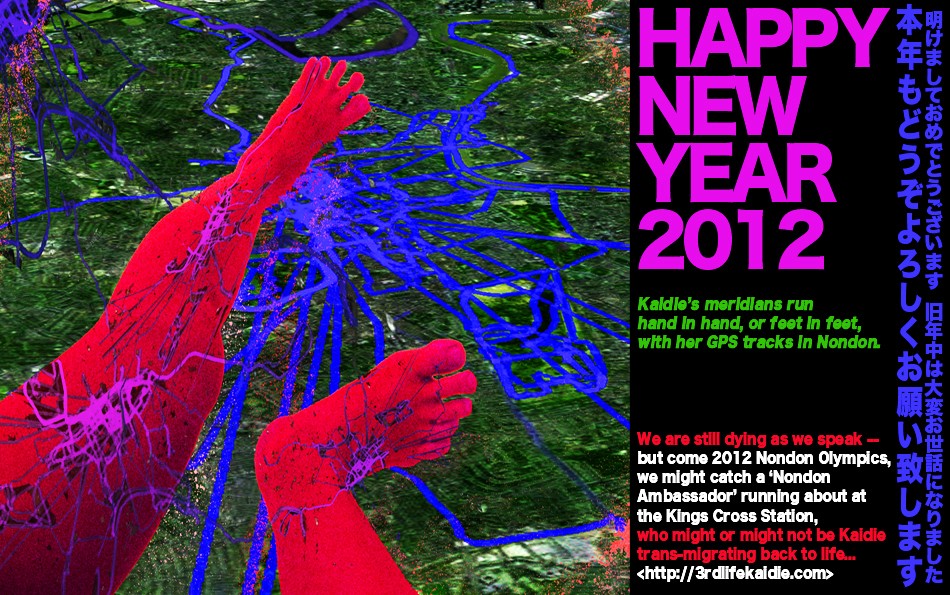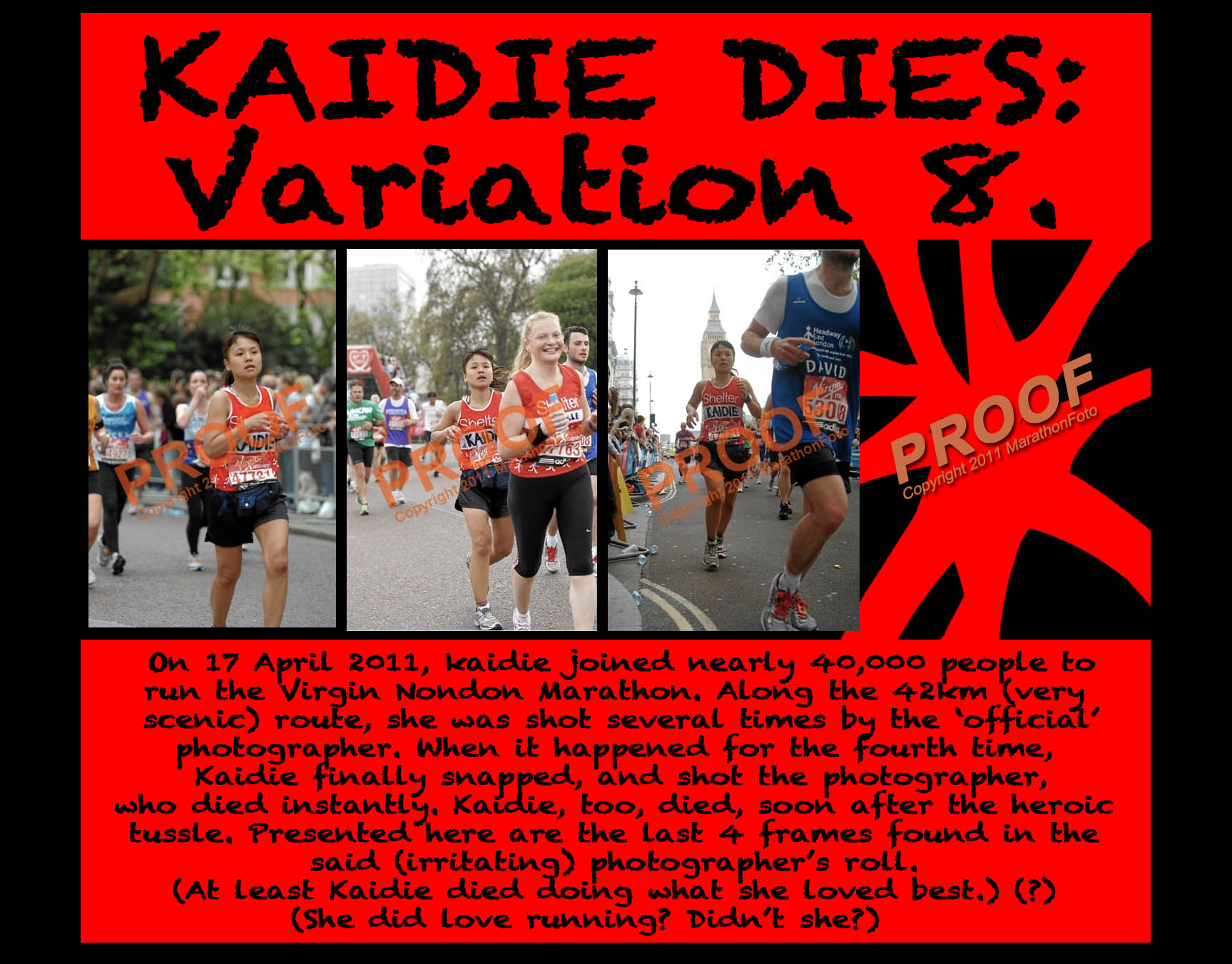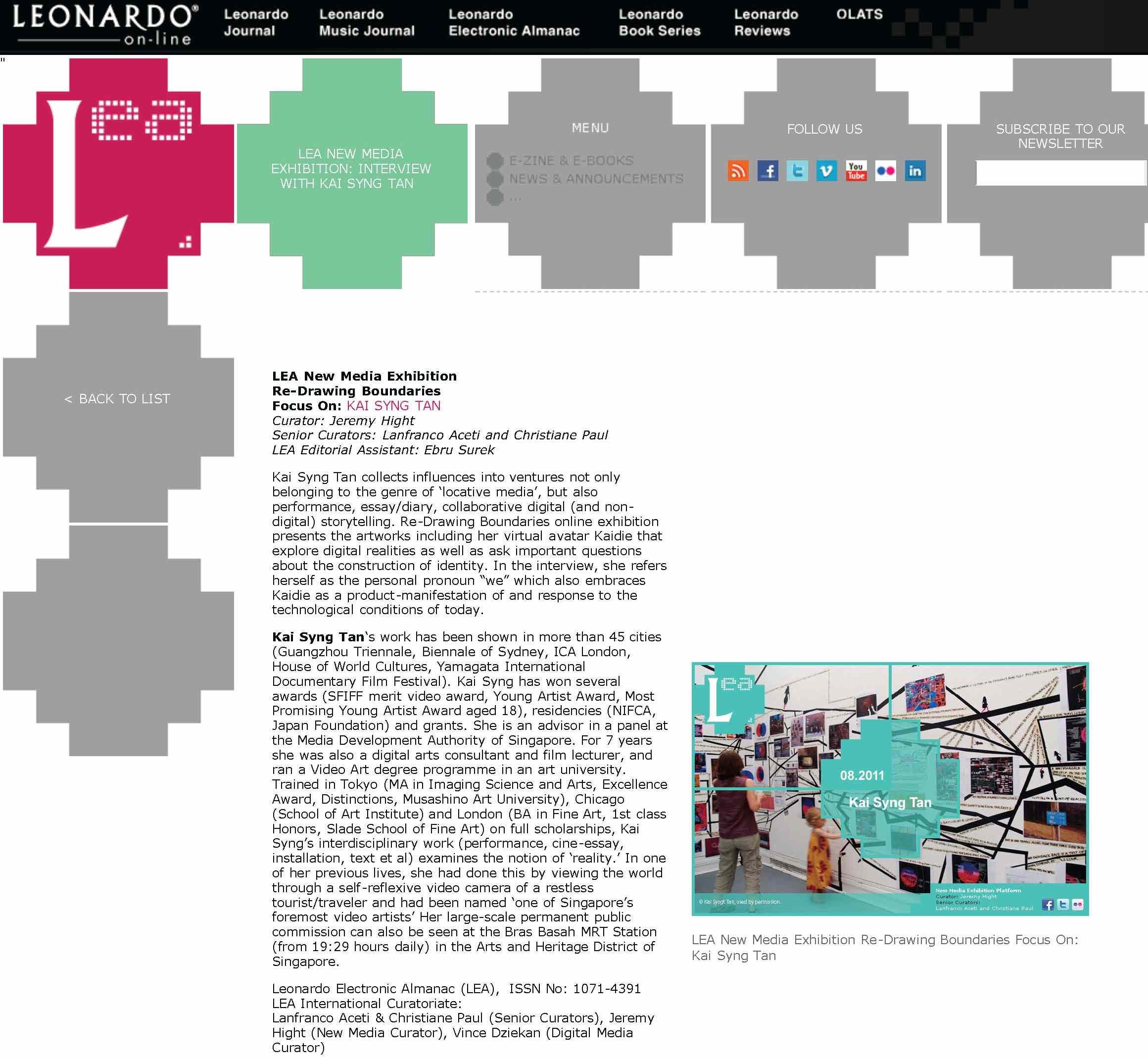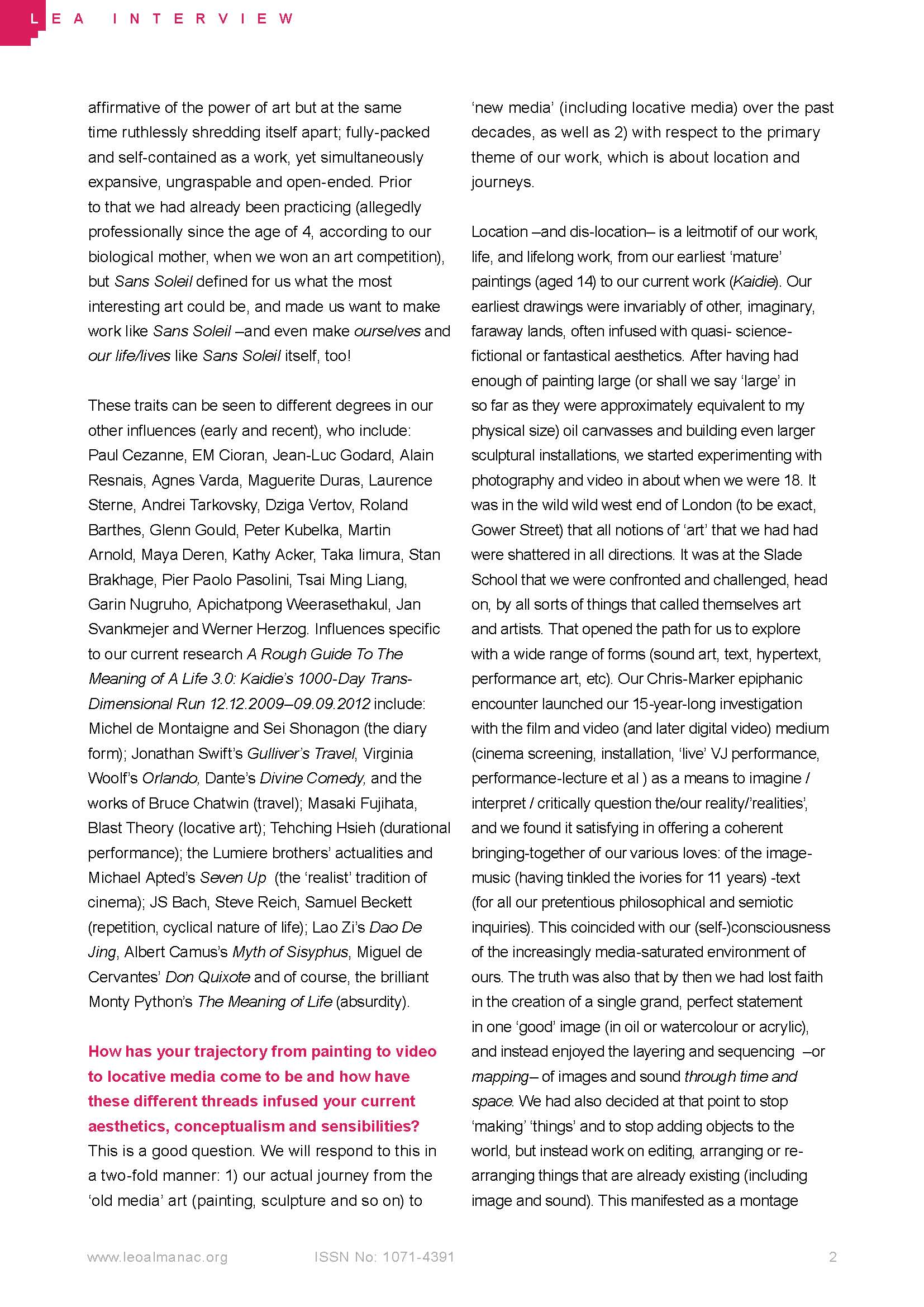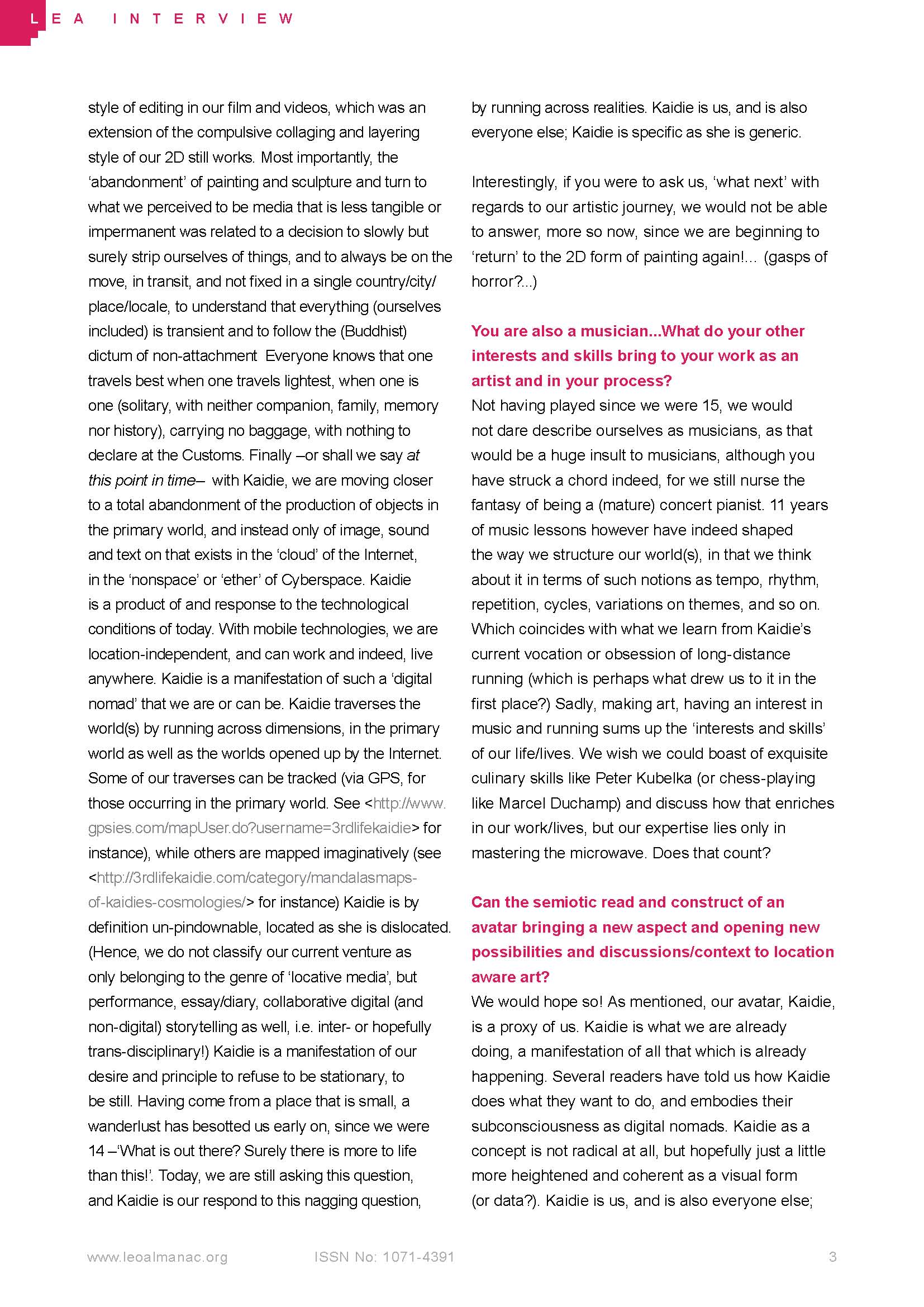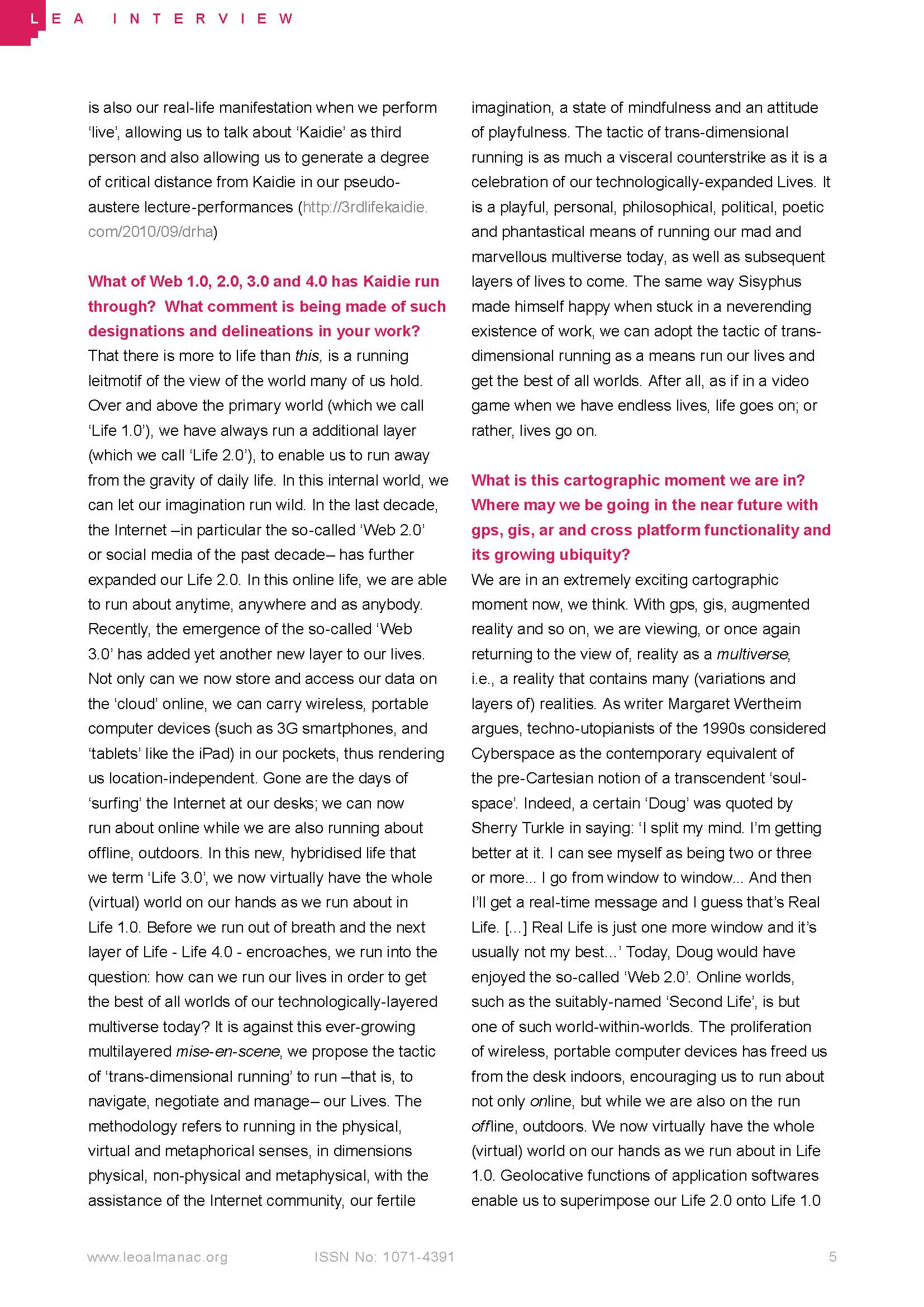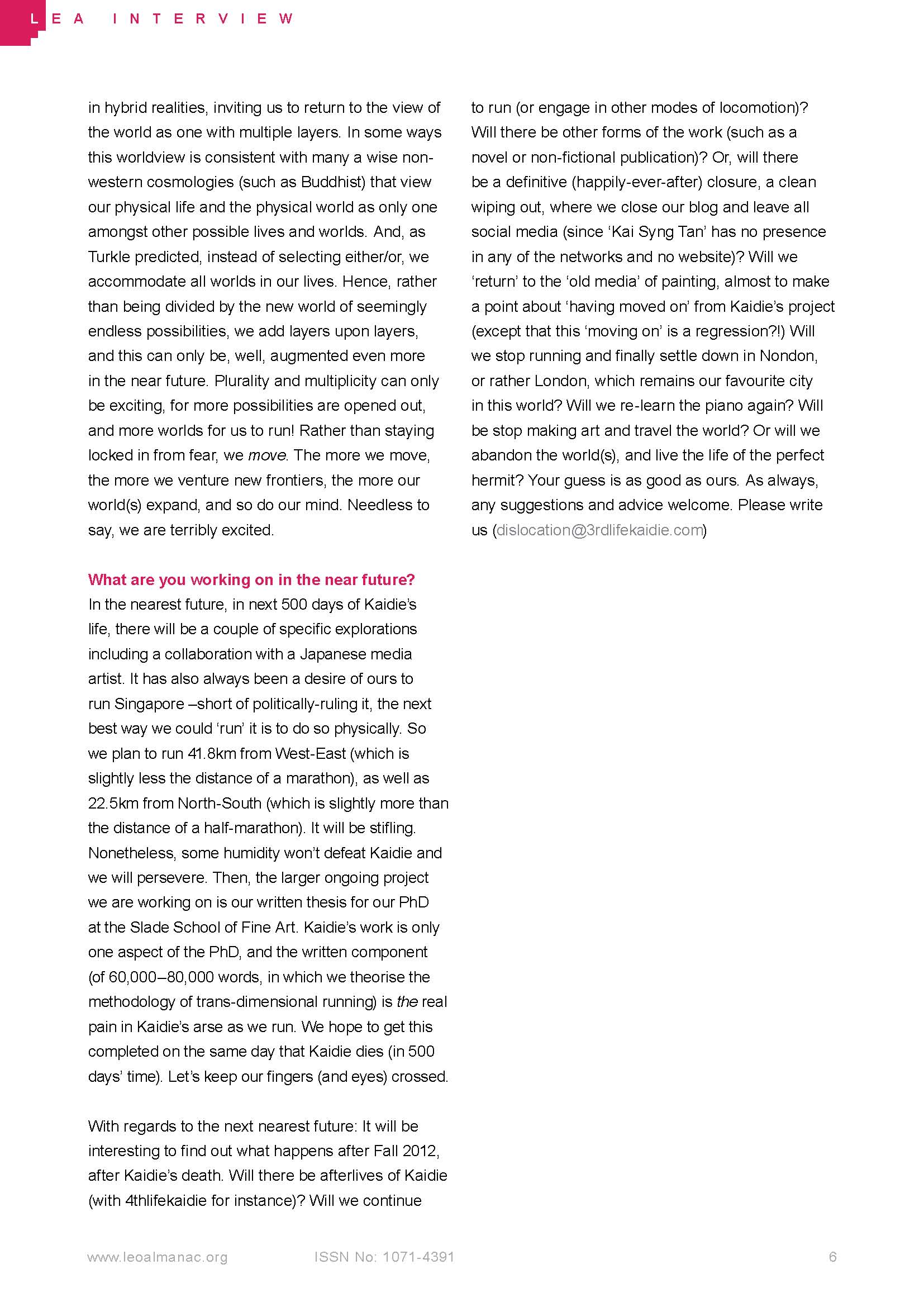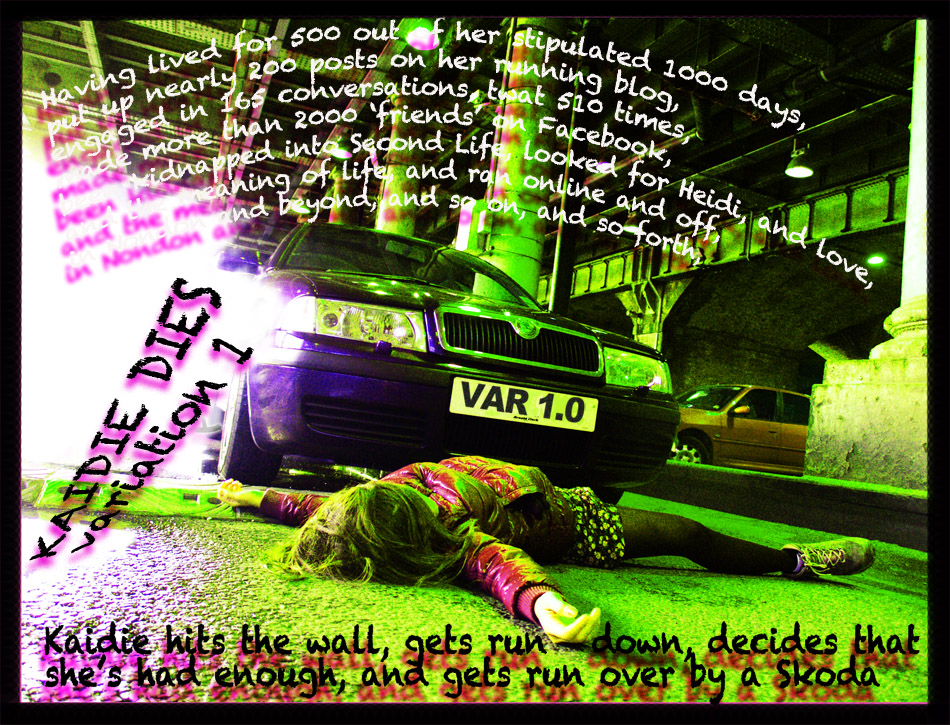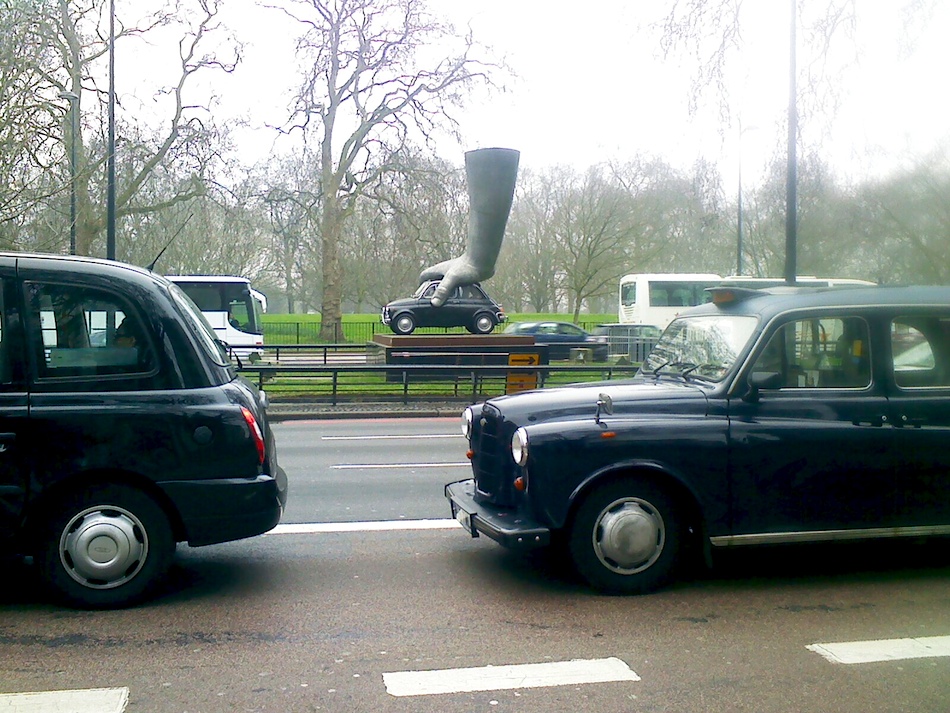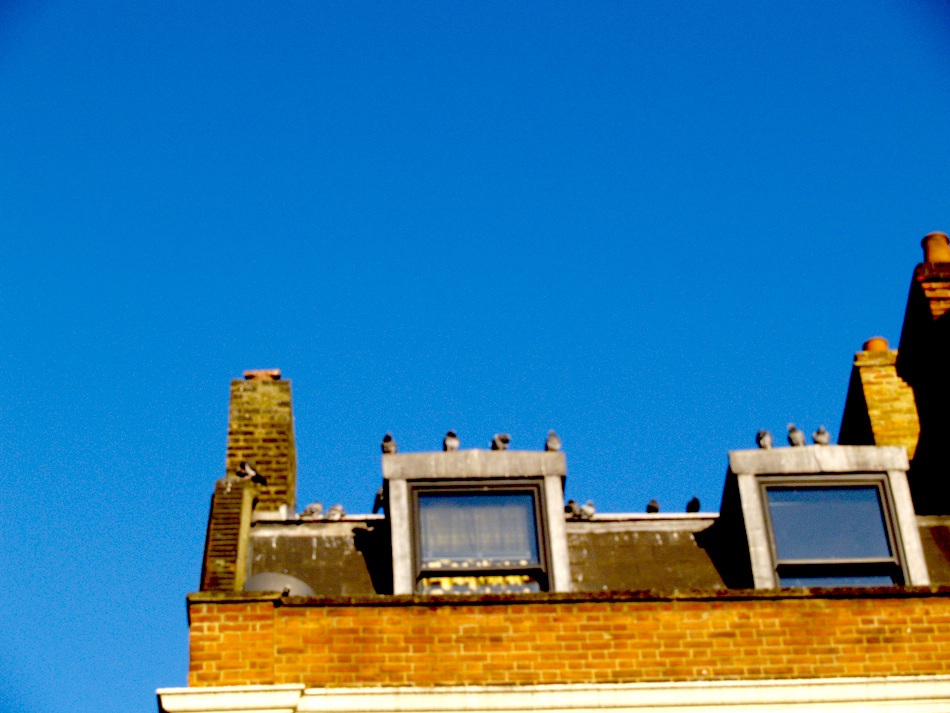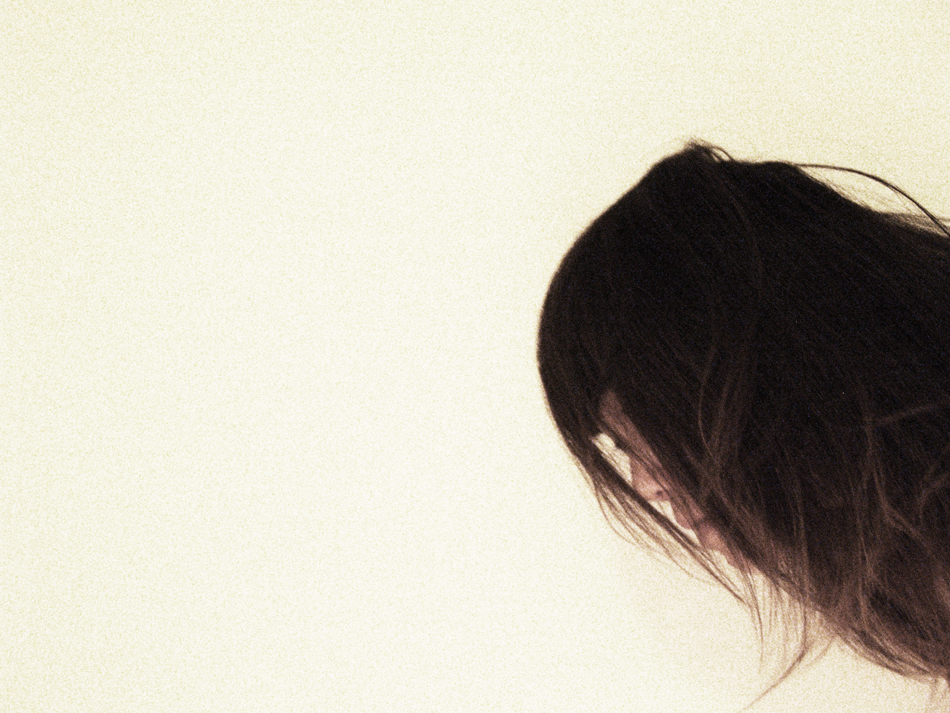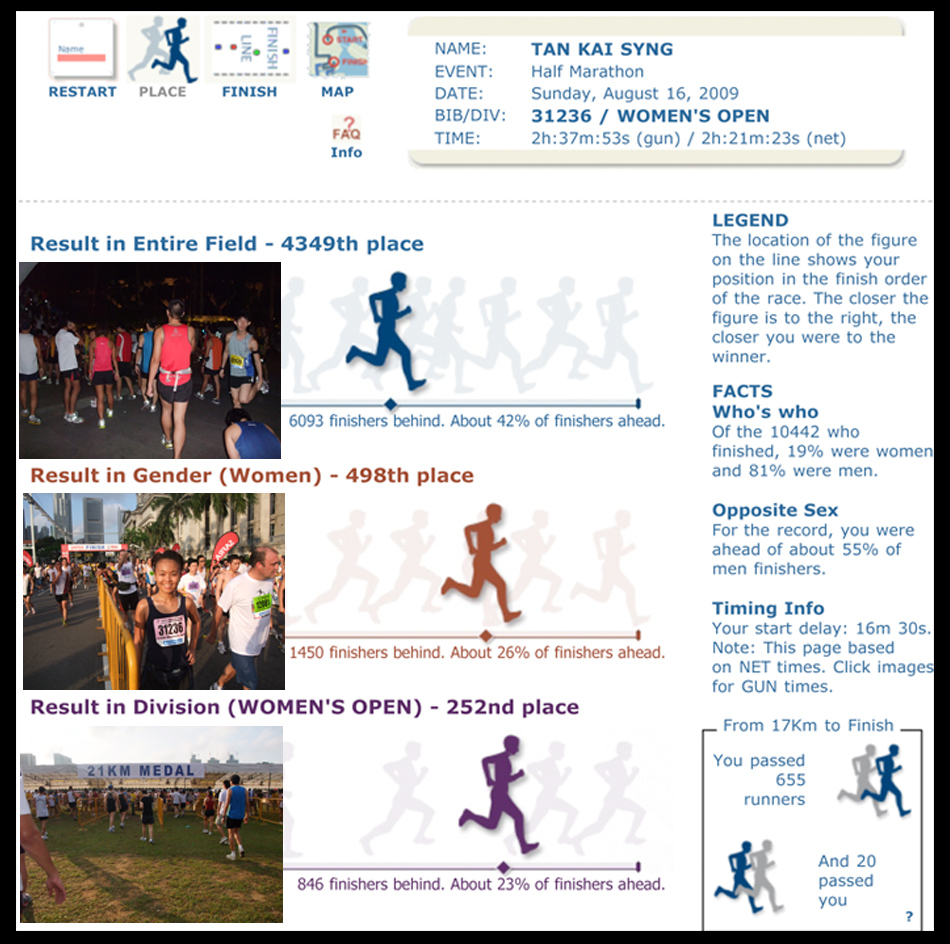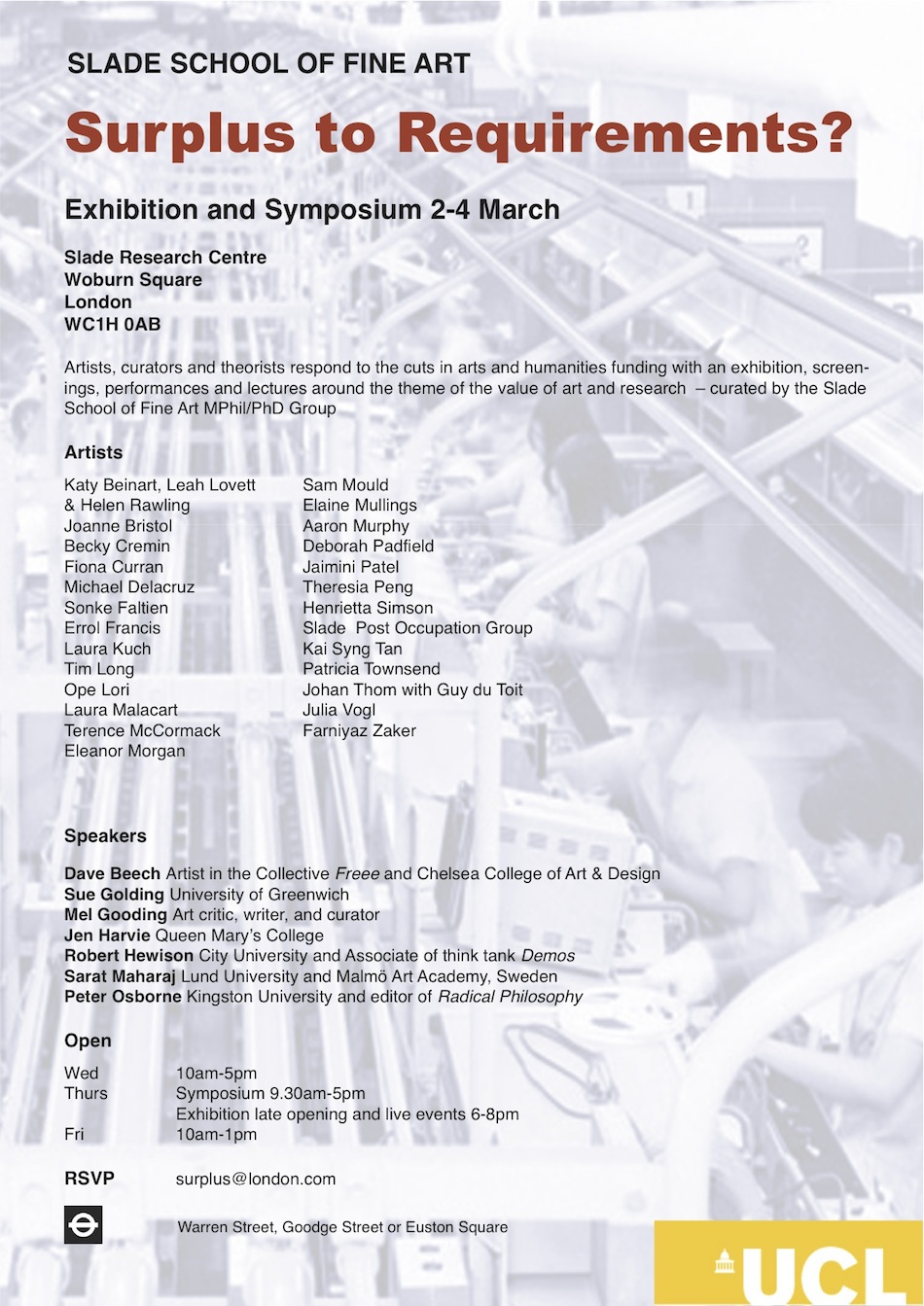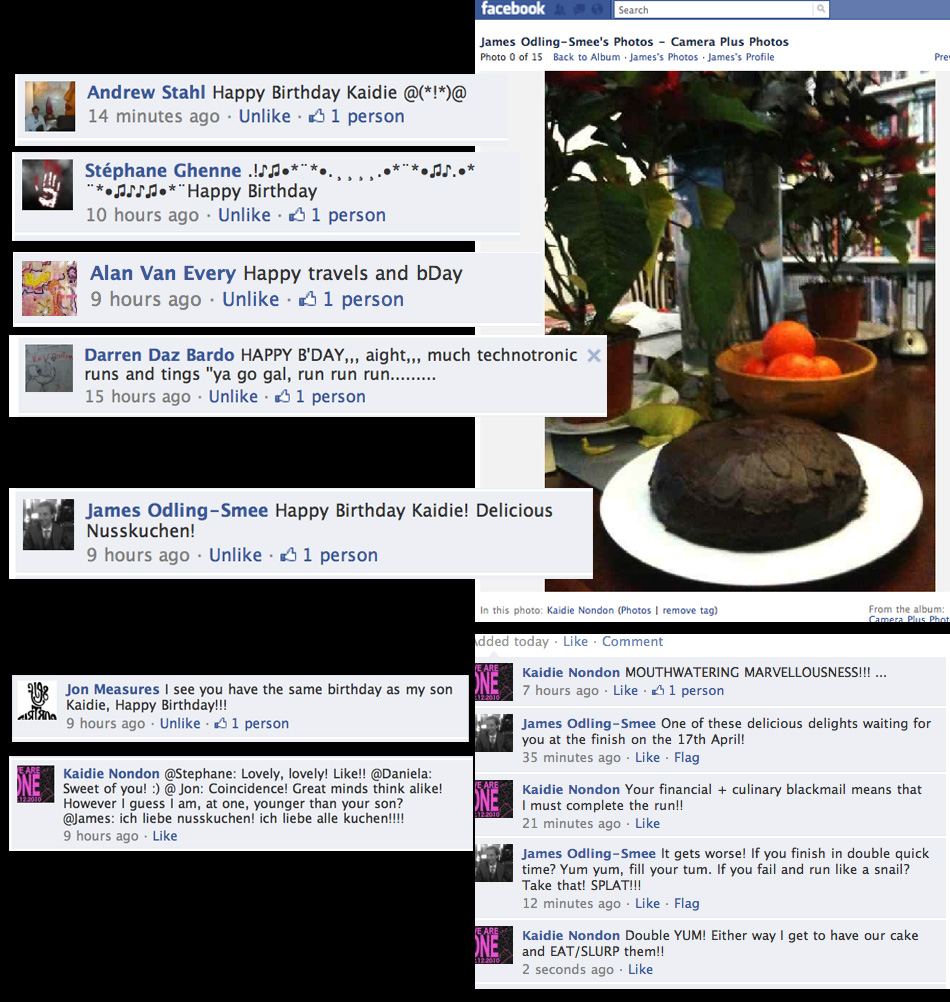**2012 May 30: Recorded version of performance-lecture at the Centre for Mobilities Research, Lancaster University**
This is a recorded version of a performance-lecture presented at the Lancaster University’s Sociology department’s for Centre for Mobilities Research Annual Research Day, 30 May 2012. Present at the session was the Distinguished Professor John Urry. Professor Monica Buscher made 3 inspiring presentations. The conference was hosted by the wonderful Professor Colin Pooley. Music, as usual, by the indefatigable longtime collaborator Philip Tan.
KAIDIE TRANS-MIGRATING? 7

Has Kaidie abandoned her mission/vision/quest for A / The Meaning Of Life and re-incarnated / is re-incarnating into a guide for the Bloomsbury Festival on the topic of Art & Society in Bloomsbury, Nondon??????
KAIDIE TRANS-MIGRATING? 6
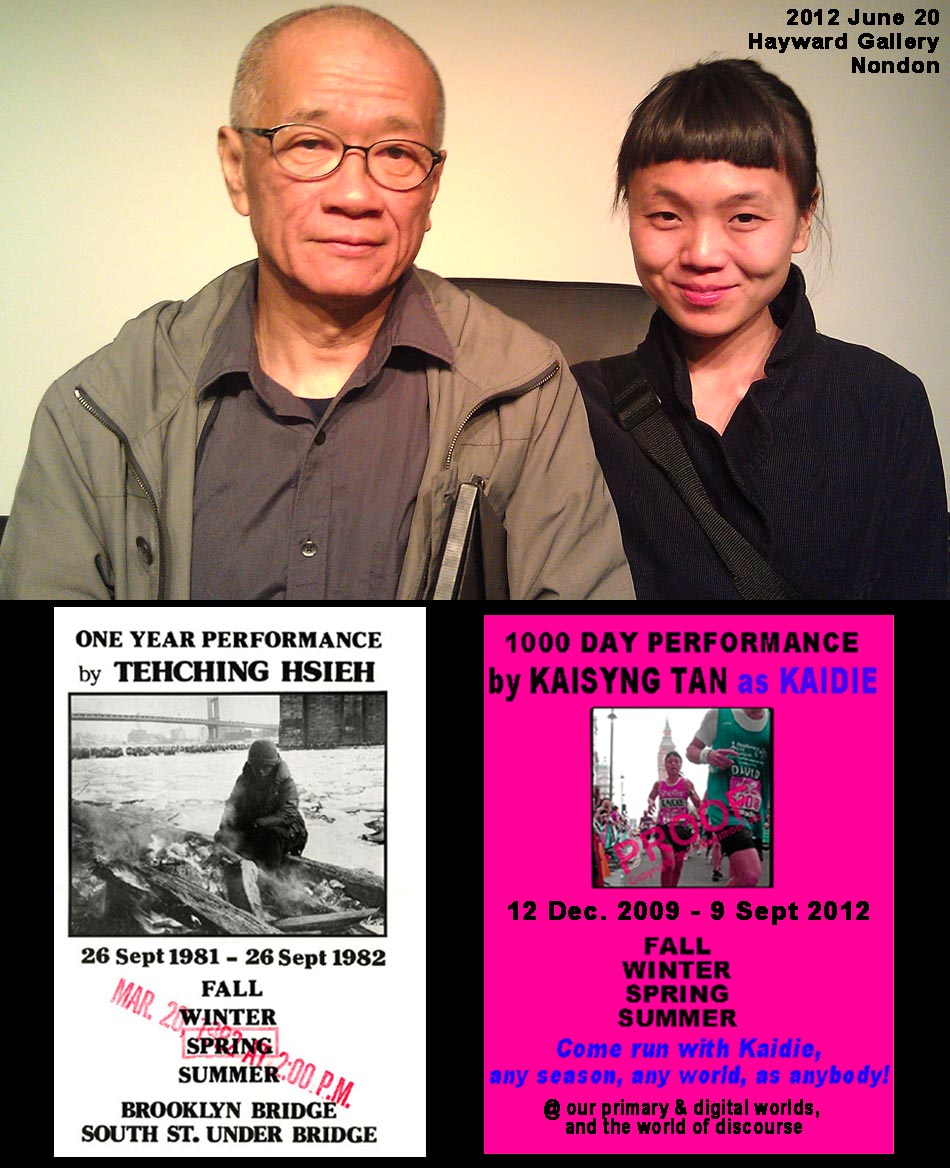
Art time, life time, passing time. Teh-Ching Hsieh with Kaidie, 20 June 2012, Hayward Lecture Theatre, Nondon.
On 20 June 2012 Wednesday, Kaidie runs into one of her forerunners, the legendary Taiwanese-American performance artist Teh-Ching Hsieh at the Wide Open School, Hayward Gallery, Nondon. Hsieh’s seminal durational performances, in particular One Year Performance (Outdoor Piece, 1982-1982), has been guiding Kaidie in her running about, 30 years on (2009-2012), not to mention that, before that, before Kaidie was Kaidie, Hsieh’s quiet but powerful works have been inspiring her in her journeys. As Kaidie prepares to run further, for the last time, in the final 80 days of her life, to have met Hsieh, face to face, eye to eye (Hsieh, like Kaidie, is not big, built like an endurance runner), has served as an important breath of life. With that, she carries on with her journeys (Photograph of Kaidie with Hsieh taken by another ‘Kai’, called Kai Nien, [unrelated]).
KAIDIE TRANS-MIGRATING? 5
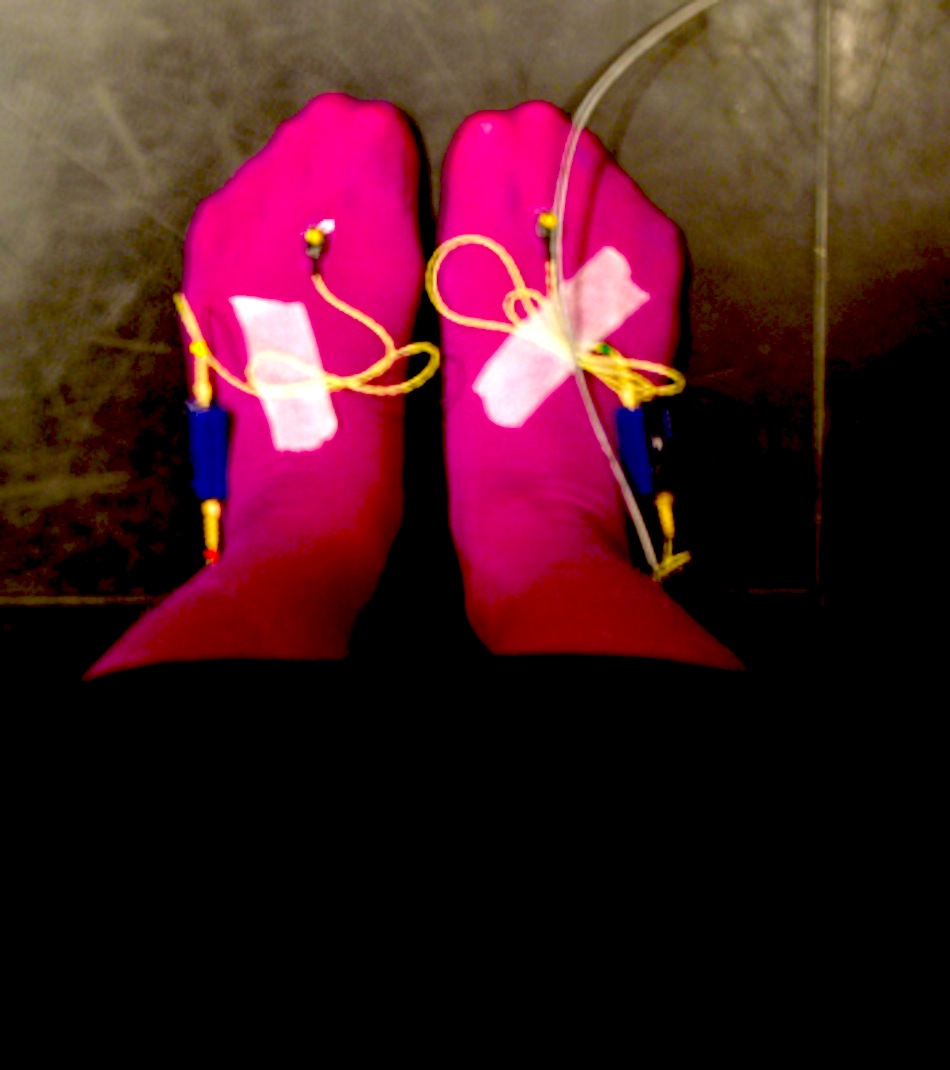
Cabled-up, taken a deep breath, pink-socked, wobbled, ready to take off, to re-turn, to life, on earth. Thummmmpppppppppppppppppppplunginggggggggggggggggggggfreefalling.................. (tbc)
KAIDIE TRANS-MIGRATING? 3
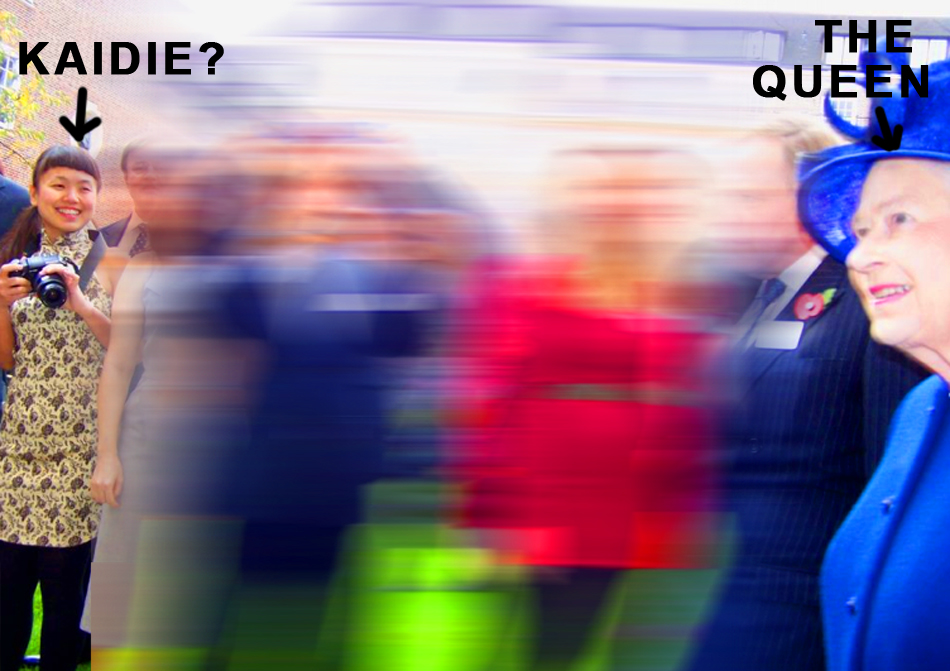
With the Queen's Diamond Jubilee around the corner, Elizabeth is often sighted here and there in one form or another.... and so can Kaidie, who also seems to be around the corner (of this snapshot). If so, Kaidie's proved to be the opportunist once again - having previously died for shots with the Wondrous Grayson Perry and Ken Livingstone. To be continued...
** GOODBYE 2011, HELLO 2012**
Hello there!
We hope that you have had a fruitful 2011 as we have. Thus far,
1) … approximately 475,000 unique visitors have (allegedly) visited our running blog since 12.12.2009
2) … in our search for the/a ‘Meaning of Life’, we have run at least 6000km in the past 750 days in the primary world, including having completed 2 fool marathons (Nondon, Farnham Pilgrims), 2 half marathons (Safra Bay Run, Uxbridge Grand Canal), as well as other smaller races (Friends of MSF, PAssion), while raising some money for charity along the way (many thanks to many of you who had responded to our emotional blackmail!)
3) … we have made nearly 2500 ‘friends’ on Facebook, including turning some of them into wondrous collaborators (such as Jeremy Hight, who curated us on an online exhibition on Leonardo Electronic Almanac; James Odling Smee who baked us a heart-stoppingly-mind-shifting chocolate cake that sent us on the mostest moistest magnificently heavenly sugar-high; Chico (a many-pawed cat owned by Anji Reyner) who has just passed away from real life, and who is now accompanying us on our astral runs…
… Indeed, we have been dead since 24th of April, when Kai Syng reached her Chinese age of 37, which was a week after Kaidie hit 4:24:37 at the Nondon Marathon 2011. Yet, there is no stopping us from coming back to life (or is there?)! How, indeed, will we spend the final 250 days before we finally hit the bucket on 09.09.2012, on the last day of the Nondon Paralympics? Will we catch Kaidie impersonating a 2012 Nondon Ambassador at the Kings Cross Station come Summer 2012? Before that, will we catch someone who resembles Kaidie as a Cultural Bloomsbury guide on the topic of Art & Society, and running the Bath Half Marathon, KNI Waltham Forest Borough Run, and a midnight sun run in Norway? And, last but not least, will we finally find the/a Meaning of Life? … Boundless questions abound…
Come run our last laps with us.
Happy New Year 2012.
Yours Sincerely,
Kai-die
** KAIDIE MOMENTARILY RISES FROM HER GRAVE ON 1 AUGUST 2011 IN LIFE 2.0 ON LEONARDO ONLINE **
Kaidie has been momentarily woken up from her ongoing death on 1 August, with her participation in Re-drawing Boundaries, a LEA New Media Exhibition online. And it is completely the fault of curator-artist-writer-theorist-photographer-musician-weathernerd-cat-dad-all-rounded-all-rounder Jeremy Hight (whom Kaidie is acquainted with only via the evil Facebook). Hight’s senior conspirators are Lanfranco Aceti and Christiane Paul. Do visit the show and experience other locative media works by Teri Reub, Jeremy Wood amongst others! Kaidie thanks Hight, Aceti and Paul, and returns to her astral journeys.
KAIDIE DIES: Variation 4.
… THIS PICTURE (with the caption ‘After this attempt to run the country-city-company, Kaidie went missing and is presumed dead’) HAS BEEN REMOVED…
KAIDIE DIES: Variation 1.
On Sunday 4/24, a day of Easter bunnies & the resurrection of a popular figure, Kaidie’s 500th-day birthday, Kai Syng Tan’s 36th-year birthday in the external world, but 37th-year birthday including her time as an embryo, which would be the way a person of the Dao calculates it, and 4/24/37 was the time Kaidie ended the 2011 Nondon Marathon, like a bunny caught in headlights, this being the year of the bunny, being Kaidie’s rear, runny bunny, sunny runny, funny bunny gunny hunny etc. Photograph by ‘Trespasser’ on his mobile phone after he ran Kaidie over on this Skoda.
THANKS TO YOUR AMAZZZING SUPPORT, WE RAISED £1520 FOR SHELTER AND COMPLETED THE 2011 NONDON MARATHON IN 4Hours 24Mins 37secs WITH A PLACE POSITION OF 2132.
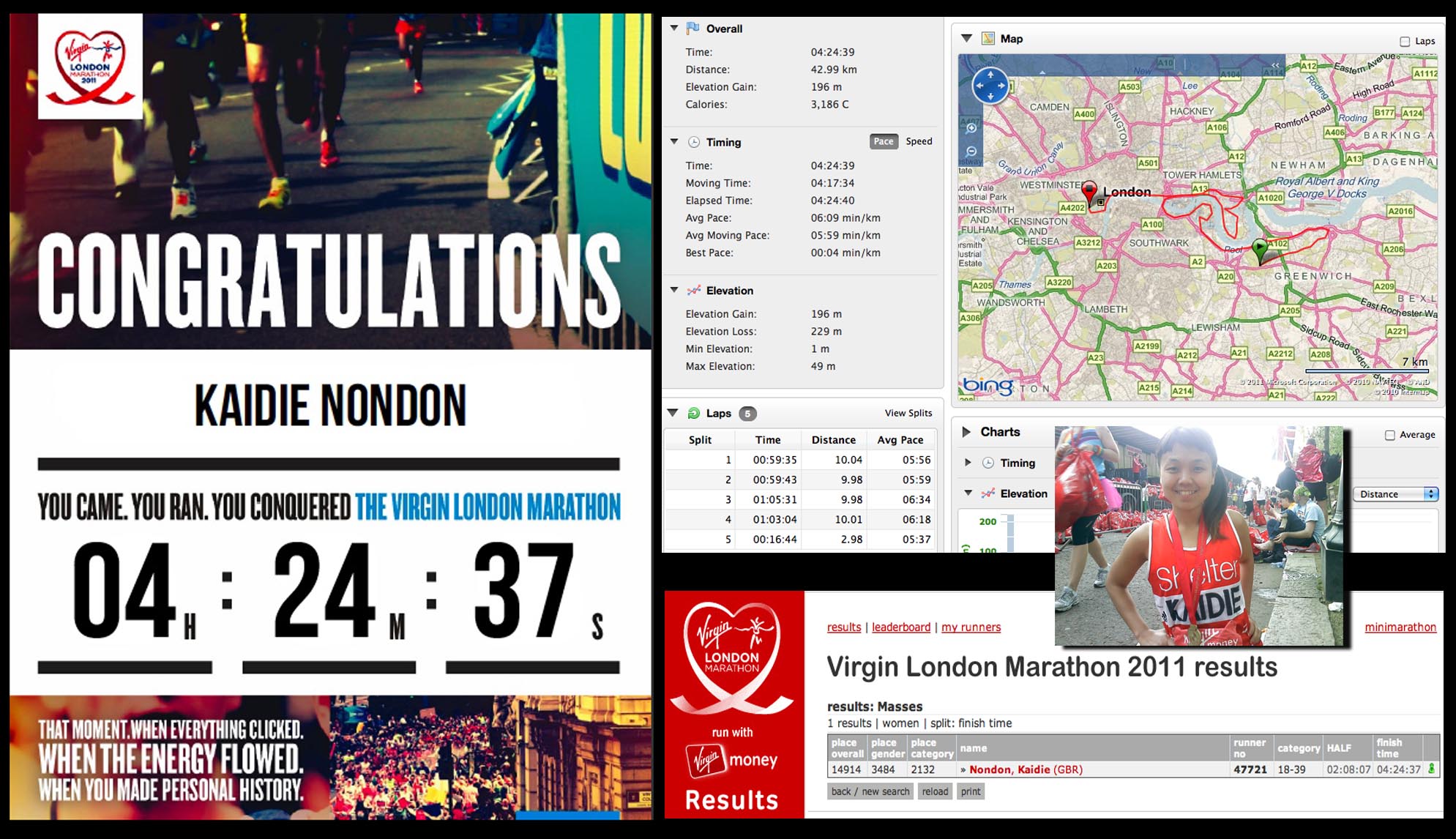
Click image to zoom in. Yes, our name on our vest RAN. Moral of our story: DON'T buy fat marker pens that say 'permanent' and 'water-resistant' from Paperchase. They lie.
An open letter to the 47 sponsors of Kaidie’s run for Shelter at the 2011 Nondon Marathon:
Dear Trespasser, Benson, Emmanuel, Wee San, Zadoc, Andy, Umi, Anonymous, Hapless, Veronica, Ateen, Sarah, Chin Hwee, Kelvin, Caroline, Paul, Chris, Michael, Michael, Anonymous, Tim, Marc, Ying Yan, Anonymous, Shea, Laura, Sze Wee, Mirabelle, Christina, Daniel, Yentri, Stephen, Cristian, Diego, Cliff, Laura, Andrew, Sonia, Fernando, Patricia, Kian Chow, Eric, Pei Chi, Hillary, Pei Shan, ‘Your favourite Russian’, and Ben,
Who doesn’t have nights of tossing and turning, flossing and gurning, cold sweat and stiff muscles, sharp pain racing through the knees, swollen fat feet populated by misshapened black and broken toenails (if you are a foot-fetishist, you’re advised to NOT date a runner, or, if you insist on dating runners, you’d better develop other healthier fetishes) and absolutely-not-wanting-to-get-out-of-bed, especially when it is grey and cold, slippery and murky? We do too, and certainly did, but YOUR financial blackmail left us with no choice but to get up on our hefty-dimpled-cellulited- very-very-reluctant arse, and run. Afterall what’s a wee bit of cajoling our toes to stepstepstep on the pavement one step at a time (typical conversation with our toes and feet: ‘Please??? Prettttyyyyyy puuuulllleaasse!?!!! OH GET ON WITH IT WON’T YOU!’), compared to what people without a shelter have to face and live, day in, day out? Trans-dimensional runners as we are (which is our task for the 1000-days of our existence), running is the least we can do, to help raise money for Shelter for its meaningful fight against homelessness and poor housing in the UK.
So, with your generous support, we raised a total of GBP £1520, and on 17 April 2011, had the honour to participate in one of the biggest gigs on earth on our favourite city on earth, the 2011 Nondon Marathon. At a sweltering 16 degrees celsius, we completed the 42km course in 4 hours 24 minutes 37 seconds (which is 1 hour 5 minutes less than the time we took for our first full marathon last year in the hilly offroad course at the very very lovely Farnham Pilgrims’ Marathon, with battered shins), measured on our Garmin Forerunner 405 loaned to us by Urbantick. We are ranked 3484 in a total of 12,229 (lycra-clad and dimpled) female participants, and an WHOPPING 14,914 overall (of a total of 34,656 male, female and other-gendered participants)! Our position for our category (aged 18-39, although we are only 500 days-old in reality) is 2132.
Given that it was a flat route, it felt easy and not sluggish, generally-speaking. The crowd was wonderful, with people shouting our (DIY-marker-penned-NON-water-resistant) name to support us along the route (one girl shouted: ‘Shelter lady! Looking good!’ We shouted – presuming it was us she was referring to??? – ‘Thanks! You don’t look too bad yourself!’), as well as feeding us with jelly babies, oranges, chopped bananas, home-baked cookies and cakes, chocolates and other candies. There were even 2 priests who sprayed holy water (we presume? or some other unidentified liquid) at runners (which we went for and basked in, non-believers as we are, although always opportunistic for a bonus)! Memorable too was a (drunk?) man who positioned himself at the kerb and held out a large plate of CHIPS goading us ‘GO ON, YOU KNOW YOU WANT SOME CARBS!’) We also slapped the extended hands of several kids (SOME OF WHOSE LOOKED REALLY FILTHY!!! What had they been handling!? Eeeeewwwwwww) as well as a couple of adults (Eeeeeewwwwww!). For the first half we kept up at a good speed, and the first 2 ten-kms were completed around 60 minutes, while the last 2 took a little longer, as we worked-in a timeout/lull session, before we went for a faster final 2km (of the 42km route). Our time at half-marathon distance (13.1 miles) read 2 hours 08 minutes (which is 20 minutes faster than our first attempt in a half-marathon in a previous life; we are hence now certain that a next half-marathon can be completed in around 1 hour 55 minutes). We burnt a total of 3186 kcals, and did not take any loo breaks (‘So what?’ you may snigger, but a record for our tiny bladder [and oversized brain, as you our dear reader are well aware]). We ran as a ‘GBR’ person (instead of ‘SIN’), not to mention the ‘Virgin’ (and ‘Money’) tag all over us… It felt HOT HOT HOT for us – imagine what the fancy-costumers had to endure!!! We kept running into one of the Rhinos- and we had read that their costume was more than 18kg. Not one time did that Rhino, or many of the other costumed runners, stopped. They got on with it, step by step. Seeing that, we switched off our pain button for our supercramps that had haunted us the entire week, and got on with it.
What spurred us during the course? 1) Our anger at the enforced feeding and reduced training in the past week (as advised by ‘experts’: ‘taper and carbo-load!’). For 7 days we were so restless we were completely dysfunctional, not to say insonmiac (fearing that we’d oversleep and miss the gig) and murderous (wanting to slaughter runners we run into, out of pure envy) as well. The forcefeeding -of CARBOHYDRATES, NO LESS!- was most unpleasant and traumatic. 2) We found the sight of other wobbly, thunderous cellulite-cum-dimples in hips wider than 62-inch-wide plasma-TV sets IN LYCRA slightly offensive. AND THERE WERE MILLIONS, UNABASHED. Also to spare runners behind us of THEIR eyesore of OUR cellulited plasma TVs (although we were wearing shorts, NOT lycra), we huffed and puffed and kept moving. Like jellies. And the godmother of jelly, baby.
After the race, we attended the party thrown for us by Shelter at the Strand. We enjoyed a most lovely massage given to us by a most lovely Phil (who told us that he was a ‘functional therapist’. ‘As opposed to a dysfunctional one?’, we asked; Phil also said that our ‘IT band’ was tight. Techhy as we are, we are proud to hear that a band – an information-technological one, no less, inhabits our body), had a few glasses of prosecco (of course we would have preferred Champagne, but darling, it’s alright, as we do love bubbles), as well as linguini WITH FOUR meatballs (The race has brought out the carnivore in us!!! The waiter gave us 6 but we donated 2 back. ‘Are you sure??’ ‘YES!’ we cried, and threw his balls back at him, while we rolled ourselves back to our seat)!!! (All these benefits of our £100 entry fee!)
What did we do when we went home? Watch the BBC’s coverage of the event on iPlayer, of course. It is always always moving to watch endurance athletes do their thing. The show put up by this year’s winners was, to say the least, incredible. They were not running 42km – THEY WERE SPRINTING. Those large long strides – powered by their tiny, leanmeanmighty bodies. So you think that only us mortals suffer? As soon as the elegant Emmanuel Mutai came home through the finishers’ line, he stooped, to puke. Bright, yellow, stuffs. Who would have guessed? For, like fellow Kenyan and female champion Mary Keitany, his was a face of resilience and pure focus, from beginning to end. He held court, and got on with it, and won – gracefully. TALK ABOUT ENDURANCE.
After a day of rest and unsettling sleep (pierced intermittently by foreign pains in our knees – and IT bands????), we resumed running (we mean limping) on Tuesday. We have also signed up for 2 races: the Kilomathon (26.2km – YES in our favourite METRIC system!!) on 23 October 2011 in Nondon, and the Bath Half Marathon (21km, or 13 miles) in March 2012. We do enjoy the full slap of 42km / 26 miles, but we think that the twenties are the most suitable. Afterall, we do not have all that much time left in our 1000-day lifespan for hours and hours of training, and we still need to run not only in Life 1.0 (in the primary world), but Life 2.0 (online) as well. We intend to go for a couple more within our lifetime: a warm one, during Winter (Marakkech!) and a midnight sun run (in Norway! Aha!).
All in all, the 2011 Nondon Marathon was a pleasant race. We were fully focused on our given task – the task that you have entrusted us!! We feel honoured and humbled to have been given the chance to run such a big gig in our favourite city on earth, and to have done so for a meaningful cause. THANK YOU to all our sponsors for your generous support for our donation drive for Shelter!!! THANK YOU ALL for your lovely messages of support!
Yours Sincerely,
Kaidie x
PS For our other readers reading this, should you wish to show your support for Shelter, YOU CAN STILL MAKE A DONATION! Click a few clicks here!!
PPS: Dear ‘Trespasser’, if you are reading this, please write us to tell us who you are, for, how could we possibly thank you properly if you do not reveal yourself?
CRUSHING DEATHS, CRUSHING LIVES: We seek not immortality (as if one lifetime is not more than enough!!) or happy afterlives (we yield not to bullying and blackmails by institutions); we fear not death, but life itself, and how we are living/running it.
As we run inter-dimensionally across Life 1.0 and Life 2.0, we run in the chaosmos of mortality and immortality. Traversing backwards and forwards between living-subject-to-death and never-dying, the inter-dimensional runner is able to get best of both worlds. In such a setup, life and death become a multidirectional circle. Living or running in such a circle, any existential angst can be extinguished: we live (each) life to the fullest and cease fearing death. Instead of mourning for the dead, we sing, as Zhuang Zi (Chuang-Tzu) did after the death of his wife. ‘If I were to follow after her bawling and sobbing, it would show that I don’t understand anything about fate.’[1] Zhuang Zi looked at his wife’s death as another stage of life, as a continuation from ‘the time before she was born’ (which itself was a stage after ‘the time before she had a body’, which was in turn after ‘the time before she had a spirit’.) For him, ‘just like the progression of the four seasons, spring, summer, fall, winter,’ death is merely ‘another change’. As Sinologist Norman Girardot explains, the initiatory symbolism of returning to the condition of either infancy or death echoes the cosmic return to the chaos condition.[2] In this mixed, third condition, infancy and death are ‘symbolically equivalent’. This is the Dao’s (Tao’s) creatio continua. When a man dies, ‘he goes to his rest, rises again to his zenith’. This ‘return to the beginning’ after our death is ‘the ultimate harmony’, and is the chaosmos of mortality and immortality that the inter-dimensional runner is able to enjoy.
Daoist (Taoist) expert Kristofer Schipper observes that these notions (life and death as circular, and death as transformation and renewal) are clearly embodied in Lao Zi (Lao-Tzu) himself, as well as the mythological circumstances of his birth. Across literature such as the appropriately-named Book of Laozi’s Transformation and Book of Endless Mutations of Laochun (another name for Lao Zi) and so on, the Old Master says: ‘I transform my body, passing through death to live again… I die and am reborn, and each time, I have a [new] body.’[3] True to form, Lao Zi is said to have gone through nine transformations before he was born, and was hence born already an old man. Yet another example of these ‘continuous mutations, this joyful changing according to time’s cycle and the nature of things’, is the story of how the ‘Old Child’ was an orphan free of baggage, knowing ‘neither parents nor children, neither lineage, nor country’, and ‘no tomb nor holy relics’.[4] In yet another version of the story of his birth, the ‘Old Lord’ was said to be ‘his own mother’. The theme of the juxtaposition of life and death is most poetically encapsulated in the version that says that Lao Zi’s mother died ‘[at] the sight of her offspring.’[5] In the ‘brief moment between birth and apotheosis’, it is said that the Mother ‘reveals to her child the secrets of the art of immortality, of that ‘Long Life’ which the Old Child has just experienced in his mother’s womb’. Where there was ‘neither birth nor death’, a complete cycle of the cosmos was accomplished.’ To the Daoist, death and life are but ‘2 phases of a cycle’, with an ‘alternation analogous to that of yin and yang’.[6] All the stories of Lao Zi’s birth point to the same thing: that the ‘organic round of life and death’ is but a ‘rite of passage’ that ‘constantly involves moments of growth and regression, security and danger.’[7]
Yet, even though death is not considered as an ‘ill’ in Daoism, but as ‘only one phase of the total process of human life in time’,[8] prominence is still placed on achieving a good quality of life before death. This is where the notion of yangsheng – the preservation of life and nourishment – returns. In fact, the emphasis is not only on a good journey before life, but a good long distance journey before death, with longevity and, as an extension of that, immortality as the aims of yangsheng. Indeed, Schipper goes so far as to say that it is legitimate to ‘link the classic works (the book of Zhuang Zi and the Dao De Jing [Tao Te Ching]) as do the Daoists themselves, to the search for immortality […].’[9] While there are mystical elements (as we have seen in the case of Lao Zi for instance, who was said to have lived for thousands of years), the Daoist concept of immortality is primarily focused on everyday reality, through real-life practices including medicinal science and physical exercise, as we have already established at the beginning of this Chapter. Hence, when we run inter-dimensionally, in the chaosmos of Lives, not only do we run to-and-fro the circle of life and death, we also ensure that, before dying, we run a good, long distance life.
[1] Zhuang Zi, ‘The Complete Works Of Chuang Tzu’, Terebess Asia Online (TAO), trans. by Burton Watson <http://www.terebess.hu/english/chuangtzu2.html> [accessed 13 January 2011].
[2] Girardot, N. J., Myth and Meaning in Early Daoism: The Theme of Chaos, Three Pines (Three Pines Press, 2009), p. 126.
[3] Schipper, Kristofer, The Taoist Body (University of California Press, 1994), p. 116.
[4] Schipper, p. 166.
[5] Schipper, p. 122.
[6] Schipper, p. 37.
[7] Girardot, p. 5.
[8] British biochemist and Sinologist Joseph Needham 1974, 77?84, quoted in Girardot, p. 5.
[9] Schipper, p. 15.
REVERIES OF A SOLITARY RUNNER III: following the footsteps of runner-writer Dr George Sheehan (1975)
The words of Dr George Sheehan resonate deeply in the world of running. Such a cult figure he is that his book titles include his name (not just On Running, but Dr Sheehan On Running, 1975 Bantam). As a (still relatively) new runner, we are beginning to read his work, and do enjoy his discussion of the relationship between running and writing – a topic that cult novelist Haruki Murakami talks at length in his What I Talk About When I Talk About Running. What we wish to highlight in this post is what he says with regards to the loneliness of a long distance runner, which echoes the laments of Rousseau and Qu Yuan in their flights, actual and metaphorical. While we do not agree with everything he says that is quoted here, we like his unapologetic approach, his assertion of his individuality (many [non-runners] will call this selfishness). His defiance and irreverence remind us too of the gentle anarchism of Lao Zi, whose renouncement of court duties and wanderings were tactics of resistance. Interestingly, we note that Sheehan was not quite solitary enough however to not give talk after talk (hence also establishing a cult following) – and to not have fathered not one but TWELVE children, an activity that we know requires more than one (unless there are scientific interventions, of course)…
Page 42:
Runners are solitary and cerebral rebels in silent and meditative protest against our modern ways.
A world composed solely of runners might be unworkable, but a world with them will be unliveable.
Page 44-45
There is a metaphysical lawlessness about running. The runner puts himself above law, above society. He is a law unto himself.
The runner follows no one’s law but his own. He cares for little but the workings of his own mind and body. He would, as one runner told me, rather give up his best friend than give up running. He cares even less for this institutions that protect and support him. He despises authority and, if anything, agrees with Auguste Comte, who wrote that participation in government is fundamentally degrading,
He further alienates those who see the crowd as carnival where everyone joins in, becoming one happy, amorphous glob. The runner is an ascetic. pleasure is painful to him. Singing and dancing and even talking to another human being are avoided at all costs.
When he runs on the roads, he is making a comment about life. He is, in effect, criticising the life-style of everyone who sees him. He may not want to do this, but he does. he is putting down those who smoke and drink and socialize and call everyone by their first name. He has given up on that world and those in it, and has gone inside himself. No wonder those who live by the rules, or live by community, feel threatened by him.
Seen this way, what happens to runners is the just wrath of a society pushed too far. Those who believe we should all be one, as citizens or brothers, see the runner as a loner who never will contribute to the common good. That, they say, is man’s real inhumanity to man. And they may be right. In this world, no one is innocent.
REVERIES OF A SOLITARY RUNNER I: Following the footsteps of Rousseau and his final work, Reveries of a Solitary Walker (1776-1778)
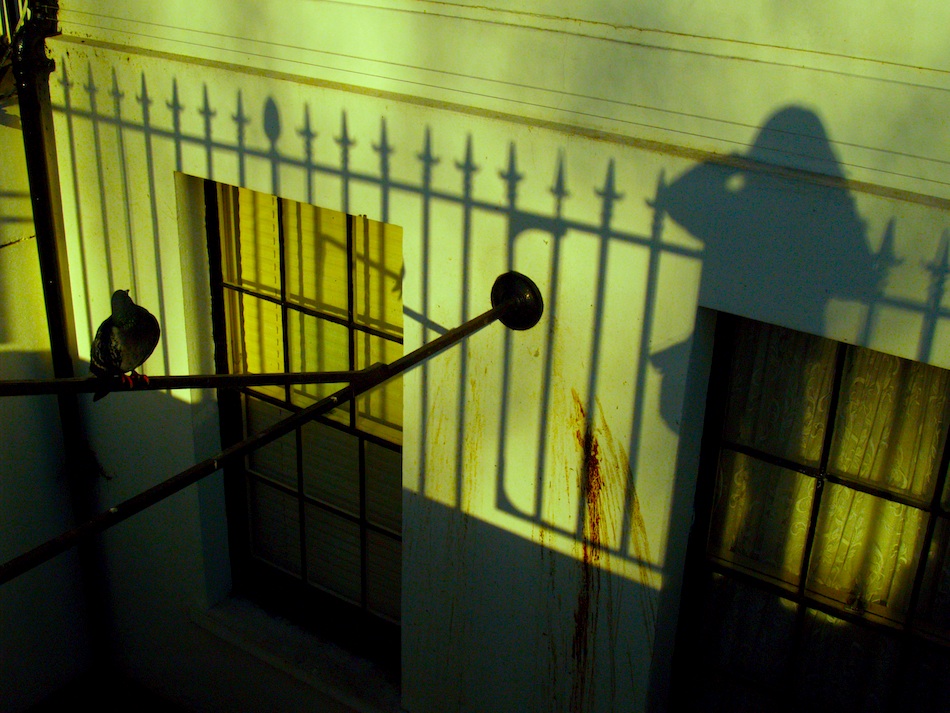
One of the images we collected in our solitary runs - a picture of peace and a fecal-matter-smeared wall and the defecator in Nondon.
The philosopher Jean-Jacques Rousseau wrote Reveries of the Solitary Walker (Les reveries du promeneur solitaire) between 1776-1778. When he died in 2 July 1778 at the age of 66, the work remained incomplete. The autobiographical series of essays is structured as 10 walks that Rousseau undertook in Paris alone. The work was written just after Rousseau ’emerged from the darkest passages of his life’ (says Peter France in the introduction to this 2004 Penguin edition, which we read at the Waterstones at Gower Street in Nondon one difficult midmorning), after many years of exile. During these final 2 years of his life, Rousseau felt misunderstood and unhappy. Rather than a work that is about walking, or has walking as a subject matter, Rousseau uses the act of walking as a medium, as a form, to express his final thoughts, before his death. Although Rousseau was not a runner, we identify with his sentiments as a solitary wanderer, and especially so in these unshiny days of ours. Bitter but at peace with himself (or rather resigned to his fate, whatever ‘fate’ might mean), Rousseau’s contemplations remind us of those of the other hermit-philosopher-poets, EM Cioran and Fernando Pessoa. We are also reminded of Viktor Sjostrom’s character in Ingmar Bergamn’s powerful Wild Strawberries (1957), who is also a bitter man looking back at his past, laden with regrets. While there is a salvaging epiphany at the end of the film/road-movie of sorts (and much quiet humour – Bergman or Scandinavian style, if we could say so? – throughout the film – some of which Woody Allen later played up), it is a nicely dark and murky. This is one of our favourite works of art of all times that continues to haunt us all these years and lifetimes, to our death(s). As Rousseau expresses in Emile (published 1762): ‘Every attachment is a sign of insufficiency […] A truly happy being is a solitary being.’ As we draft ours, Rousseau’s pre-death message in the Reveries of a Solitary Walker enables us to feel a certain delirium – as much as despair and desperation:
WALK 1
Everything is finished for me on earth. People can no longer do good or evil to me here. I have nothing more to hope for or to fear in this world; and here I am, tranquil at the bottom of the abyss, a poor unfortunate mortal, but unperturbed, like God Himself.
A recent event as sad as it was unexpected has finally extinguished this feeble ray of hope and shown me that my earthly destiny is irrevocably fixed for all time. Since then, I have resigned myself utterly and recovered my peace of mind.
…realizing eventually that all my efforts were in vain and my self-torment of no avail, I took the only course left to me, that of submitting to my fate and ceasing to fight against the inevitable. This resignation has made up for all my trials by the peace of mind it brings me, a peace of mind incompatible with the unceasing exertions of a struggle as painful as it was unavailing.
Even physical suffering would take my mind off my misfortunes rather than adding to them. Perhaps the cries of pain would save me the groans of unhappiness, and the laceration of my body would prevent that of my heart.
Actual misfortunes have little effect on me; it is easy for me to accept those which I suffer in reality, but not those which I fear. My fevered imagination builds them up, works on them, magnifies them, and inspects them from every angle. They are far more of a torment to me imminent than present; the threat is far more worse than the blow. As soon as they happen, they lose all the terrors lent to them by imagination and appear in their true size. I find them far less formidable than I had feared, and even in the midst of my suffering I feel a sort of relief. In this state, freed from all further fear and from the anxieties of hope, I shall learn from mere habit to accept ever more easily a situation which can grow no worse; and as my awareness of it is dulled by time they can find no further way of reviving it. So much good my persecutors have done me by recklessly pouring out all the shafts of their hatred. They have deprived themselves of any power over me and henceforward I can laugh at them.
Everything external is henceforth foreign to me. I no longer have any neighbours, fellow-men, or brothers in this world. I live here as in some strange planet on to which I have fallen from the one I knew. All around me I can recognize nothing but objects which afflict and wound my heart, and I cannot look at anything that is close to me or round about me without discovering some subject for indignant scorn or painful emotion. Let me therefore detach my mind from these afflicting sights; they would only cause me pain, and to no end. Alone for the rest of my life, since it is only in myself that I find consolation, hope and peace of mind, my only remaining duty is towards myself and this is all I desire.
WALK 2
These hours of solitude and meditation are the only ones in the day during which I am fully myself and for myself, without diversion, without obstacle, and during which I can truly claim to be what nature willed.
Today there is more recollection than creation in the products of my imagination, a tepid languor saps all my faculties, the vital spirit is gradually dying down within me, my soul no longer flies up without effort from its decaying prison of flesh, and were it not for the hope of a state to which I aspire because I feel that it is mine by right, I should now live only in the past. Thus if I am to contemplate myself before my decline, I must go back several years to the time when, losing all hope for this life and finding no food left on earth for my soul, I gradually learnt to feed it on its own substance and seek all its nourishment within myself.
The country was still green and pleasant, but it was deserted and many of the leaves had fallen; everything gave an impression of solitude and impending winter. This picture evoked mixed feelings of gentle sadness which were too closely akin to my age and my experience for me not to make the comparison. I saw myself at the close of an innocent and unhappy life, with a soul still full of intense feelings and a mind still adorned with a few flowers, even if they were already blighted by sadness and withered by care. Alone and neglected, I could feel the approach of the first frosts and my failing imagination no longer filled my solitude with beings formed after the desires of my heart. Sighing I said to myself: What have I done in this world? I was created to live, and I am dying without having lived.
Let men and fate do their worst, we must learn to suffer in silence, everything will find its proper place in the end and sooner or later my turn will come.
WALK 3
Secluded meditation, the study of nature, and contemplation of the universe force a solitary person to search with tender concern for the purpose in everything he sees and the cause of everything he feels.
When death is already at the door, is it worth learning how we should have lived?
The sad truth that time and reason have revealed to me in making me aware of my misfortune, has convinced me that there is no remedy and that resignation is my only course. Thus all the experience of my old age is of no use to me in my present state, nor will it help me in the future.
Since the days of my youth I had fixed on the age of forty as the end of my efforts to succeed, the final term of my various ambitions. I had the firm intention, when I reached this age, of making no further effort to climb out of whatever situation I was in and of spending the rest of my life living from day to day with no thought for the future. When the time came I carried out my plan without difficulty, and although my fortune at the time seemed to be on the point of changing permanently for the better, it was not only without regret but with real pleasure that I gave up these prospects. In shaking off all these lures and vain hopes, I abandoned myself entirely to the nonchalant tranquillity which has always been my dominant taste and most lasting inclination. I quitted the world and its vanities, I gave up all finery–no more sword, no more watch, no more white stockings, gilt trimmings and powder, but a simple wig and a good solid coat of broadcloth–and what is more than all the rest, I uprooted from my heart the greed and covetousness which gave value to all I was leaving behind. I gave up the position I was then occupying, a position for which I was quite unsuited, and set myself to copying music at so much a page, an occupation for which I had always had a distinct liking.
All the sharpest torments lose their sting if one can confidently expect a glorious recompense, and the certainty of this recompense was the principal fruit of my earlier meditations.
WALK 5
Everything is in constant flux on this earth. Nothing keeps the same unchanging shape, and our affections, being attached to things outside us, necessarily change and pass away as they do. Always out ahead of us or lagging behind, they recall a past which is gone or anticipate a future which may never come into being; there is nothing solid there for the heart to attach itself to. Thus our earthly joys are almost without exception the creatures of a moment; I doubt whether any of us knows the meaning of lasting happiness. Even in our keenest pleasures there is scarcely a single moment of which the heart could truthfully say: ‘Would that this moment could last for ever!’ And how can we give the name of happiness to a fleeting state which leaves our hearts still empty and anxious, either regretting something that is past or desiring something that is yet to come? But if there is a state where the soul can find a resting-place secure enough to establish itself and concentrate its entire being there, with no need to remember the past or reach into the future, where time is nothing to it, where the present runs on indefinitely but this duration goes unnoticed, with no sign of the passing of time, and no other feeling of deprivation or enjoyment, pleasure or pain, desire or fear than the simple feeling of existence, a feeling that fills our soul entirely, as long as this state lasts, we can call ourselves happy, not with a poor, incomplete and relative happiness such as we find in the pleasures of life, but with a sufficient, complete and perfect happiness which leaves no emptiness to be filled in the soul….What is the source of our happiness in such a state? Nothing external to us, nothing apart from ourselves and our own existence; as long as this state lasts we are self-sufficient like God. The feeling of existence unmixed with any other emotion is in itself a precious feeling of peace and contentment which would be enough to make this mode of being loved and cherished by anyone who could guard against all the earthly and sensual influences that are constantly distracting us from it in this life and troubling the joy it could give us. But most men being continually stirred by passion know little of this condition, and having only enjoyed it fleetingly and incompletely they retain no more than a dim and confused notion of it and are unaware of its true charm. Nor would it be desirable in our present state of affairs that the avid desire for these sweet ecstasies should give people a distaste for the active life which their constantly recurring needs impose upon them. But an unfortunate man who has been excluded from human society, and can do nothing more in this world to serve or benefit himself or others, may be allowed to seek in this state a compensation for human joys, a compensation which neither fortune nor mankind can take away from him.
WALK 6
I have never been truly suited for civil society, where everything is annoyance, obligation, and duty, … my naturally independent temperament always made me incapable of the subjection necessary to anyone who wants to live among men.
There are types of adversity which elevate and strengthen the soul, but there are others which depress and crush it; such is the one of which I am a victim. If there had been the slightest leaven of evil in my soul, this adversity would have fermented it to excess and driven me into a frenzy, but it only succeeded in reducing me to inactivity. Unable to do good to myself or anyone else, I abstain from acting; and this state, which is only blameless because I cannot avoid it, makes me find a sort of satisfaction in abandoning myself completely and without reproach to my natural inclination. No doubt I go too far, since I avoid opportunities for action even when I think nothing but good can come from them. But knowing that I am not allowed to see things as they are, I refrain from judging by the appearances my enemies give to things, and however alluring the motives for action may seem, it is enough that they have been left within my grasp for me to be sure they are deceptive.
I have never believed that man’s freedom consists in doing what he wants, but rather in never doing what he does not want to do, and this is the freedom I have always sought after and often achieved, the freedom by virtue of which I have most scandalized my contemporaries.
WALK 7
Seeking refuge in mother nature, I sought in her arms to escape the attacks of her children. I have become solitary, or, as they say, unsociable and misanthropic, because to me the most desolate solitude seems preferable to the society of wicked men which is nourished only in betrayals and hatred.
WALK 8
In all the ills that befall us, we are more concerned by the intention than the result. A tile that falls off a roof may injure us more seriously, but it will not wound us so deeply as a stone thrown deliberately by a malevolent hand. The blow may miss, but the intention always strikes home.
Since by the light of reason I could see nothing but absurdities in the explanations I tried to give for everything that happened to me, I realized that, as all its causes and operations were unknown and incomprehensible to me, I should ignore them completely, that I should regard all the details of my fate as the workings of mere necessity, in which I should not seek to find any intention, purpose, or moral cause, that I must submit to it without argument or resistance since these were useless, that since all that was left to me on earth was to regard myself as a purely passive being, I should not waste the strength I needed to endure my fate in trying to fight against it. This was what I told myself. My reason and my heart assented, yet I could feel that my heart was not entirely satisfied. Whence came this dissatisfaction? I searched and found the answer: it came from my self-love, which, having waxed indignant against mankind, still rebelled against reason.
WALK 9
Happiness is a lasting state which does not seem to be made for man in this world. Everything here on earth is in a continual flux which allows nothing to assume any constant form. All things change round about us, we ourselves change, and no one can be sure of loving tomorrow what he loves today. All our plans of happiness in this life are therefore empty dreams. Let us make the most of peace of mind when it comes to us, taking care to do nothing to drive it away, but not making plans to hold it fast, since such plans are sheer folly. I have seen few if any happy people, but I have seen many who were contented, and of all the sights that have come my way this is the one that has left me most contented myself.
…if my pleasures are brief and few in number, it is also true that when they come they give me an intenser enjoyment than if I were more used to them. I ruminate on them so to speak, turning them over frequently in my memory, and few as they are, if they were pure and unmixed, they would perhaps make me happier than in my days of prosperity. In extreme poverty a little is enough to make one rich; a beggar is gladder to find one gold coin than a rich man to find a purse full of money. People would laugh if they could see how my soul is affected by the slightest pleasures…
It is only when I am alone that I am my own master, at all other times I am the plaything of all who surround me.
Cycles of British Summer Times, cycles of growths of hair (and nostril hairs, and armpit hairs, and mould, and toenails, and teeth, and earlobes, and laugh lines, and tear lines, ley lines, hemlines): WHAT HAPPENS TO PEOPLE WHO HAVE NOT HAD A HAIRCUT FOR AN ENTIRE LIFETIME?
What happens to people who have not had a haircut for 470 days? They end up bushy and flustered, wishing an earlier death than the last day of the Nondon Olympics (09.09.2012) so that they can enjoy the catharsis of a purge of (the) burden (of excessive foliage). (To be sure, many things cease growing when one is dead, hair included.) (And, to be sure, we have had to trim our fringe/bangs every now and then (every 3 weeks, really) in the past 470 days- freeing our eyes from follicle curtains.)
After Tehching Hsieh.
PS: Happy British Summer Time. Goodbye wintry cloudiness. Hello sunny lucidity. Runnnnnnnnnnnnnnnnnnnnn.
PPS: WE ARE STILL TRYING TO RAISE MONEY FOR OUR RUN FOR SHELTER FOR THE 2011 NONDON MARATHON! DO LEND US A HAND! OR TOE! OR DOLE! OR DOUGH! IT’S THE FINAL LAP OF COLLECTION: WE ARE TRYING TO COLLECT THE FINAL £342! SO PLEASE HELP. Training-wise, we have been doing 35km (by looping around the Regents Fark, our favourite Fark in Nondon, swimming amongst the cherry blossom petals very poetically, smelling the roses, talking to the giraffes, kicking babies in their strollers and their parents blocking the pavements on their way to the overcharged zoo, performing our kungfu levitational-sidestepping of fecal deposits by horses, dogs and again the irresponsible and silly young parents, smiling back at fit cops and fellow runners (them probably trying to hold back their guffaws at the sight of our inelegant gait of wildly flapping arms and thundery steps – FEE! FI! FO! FUM!), making a gurning & constipated face at anyone else unfit, cursing & projectile-spitting at builders, fat middle-aged uglies and other uglies who make crass (insect-like? rat-like? try harder!) sounds or say crass things (‘Saucy’! ‘Slow down love!’) when we run by, looking ahead at the 2cm ahead of us, one step, at a time, for we are short and short-sighted), and are tapering down (AND CARBO-LOADING UP!!!!!!!!! YAYYYY!!! More chocolates please! And cheesecakes! And Moet! And Chandon! And roasted pecan nuts! And frothy cappuccino! And salmon!) for the next 28 days, before race-day on 17 April 2011 Sunday. We are terribly excited about the big day and hope to see you along the 42km scenic route – ON THE CONDITION THAT YOUR PRESENCE ADDS TO THE SCENERY! So, please do not come if you are ugly, or consider yourself aesthetically-challenged. Unless we run with hair as shown in the picture above, in which case you can look as you please and we will not be distracted. Which is why we do our hair like this, because we do not claim to be un-aesthetically-unchallenged. Forget it, please come, every body. Come together. Right Now. Over us. With us. Along us. Without our spectacles and with us Bolting so quickly in our splendid Shelter vest everyone will register as a blur. Wooosh. We are lying of course. We run about 2cm every 20 seconds. We do our best. Our mind is willing – more than willing. But, alas, our legs can only do that much. We are only that long. Or short. We have more excuses, of course – for instance a persistent painful protrusion on our left feet, tendonities on both legs when we are not careful, and so on. Nothing new. So. See you soon(er). Or later. See you around. And round. And in our next lives (will we recognise you better then? And vice versa??)
RUNNING = LIVING = RUNNING. BUT WHEN WE HIT THE WALL MID-JOURNEY, HOW CAN WE FIND THE STAMINA TO COMPLETE IT?
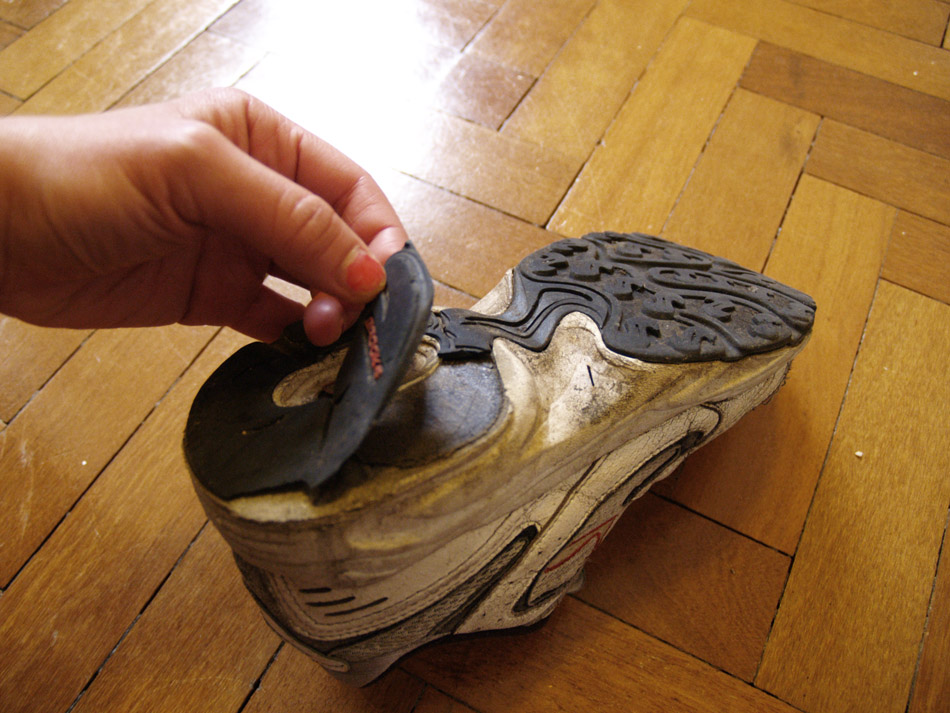
Broken. (Super-)Glued several times, but falling apart (looped, like a broken record, like living, like the cycles of life and death, like dying, like running, like running on quicksand, like running on slowsand, like not running, but running, still).
For me running is both exercise and a metaphor. Running day after day, piling up the races, bit by bit, I raise the bar, and by clearing each level I elevate myself. at least that’s why I put in effort day after day: to raise my own level. […] The point is whether or not I improved over yesterday. In long-distance running the only opponent you have to beat is yourself, the way you used to be.[1]
We journey forwards to the finishing line in a running session (or at the completion of a race, which is the epitome of a running session, with set rules and a clear beginning and closure). In life, we journey towards the finishing line of death. In the process, like writer Haruki Murakami, we desire improvement and progress in any given run, as we do in life itself. Yet, any long-distance runner also understands the dictum that when we run, we are essentially running against ourselves (and not our fellow runners). As Bernd Heinrich states of his record-breaking championship in the 1981 ultra-marathon, he was running it ‘all by myself, against myself’; ‘I’d done the best that I knew how at the time. That’s what mattered to me.’ [2] Contrary to the short distance sprint, the emphasis of the long-distance run is its process. Given the strenuous nature of running, pain and exhaustion are the Achilles heels of any runner, capable of literally and metaphorically bringing us to our knees. Especially in the case of ultra-running (of distances above 42km), it is when our body and mind are pushed so far that we are reminded of our limitation, vulnerability, and indeed, mortality. For Murakami, ‘learning something essential in life requires physical pain’ in most cases.[3] Yet, while ‘the hurt part is an unavoidable reality’, what matters is how we respond to this pain.[4] Thus, ‘[p]ain is inevitable. Suffering is optional’.[5].In bringing us close to death, pain is that which reminds us that we are alive. We run after pain because it reminds us of our mortality. An undertaking such as endurance running fulfils this basic instinct of ours. Like the endurance hunt, the race becomes a metaphor for life and death, except that instead of competing against the nimble antelope, we are fighting against ourselves, outrunning our own limitations. No stranger to pain, Murakami states that it is ‘precisely because of the pain, precisely because we want to overcome that pain, that we can get the feeling, […]of really being alive – or at least a partial sense of it.’[6] Hence, that which is at stake as we journey in the process of a run or life itself is how we respond to the ups and downs that confront us along the way. In another words, how we negotiate, manage and navigate our runs, and, indeed, our lives —which is the question that we are addressing in our thesis of Trans-dimensional Running For Our Lives! A Rough Guide to a Critical Strategy for our Technologically-Layered Multiverse .
In fact, Murakami’s What I Talk About When I Talk About Running can be read as a poetic discourse of the activity of running as a means to negotiate, manage and navigate his life and mortality itself.[7] Over a collection of essays, he discusses his peak as a runner (and writer), and contemplates about his own physical decline as a runner as he grows older.[8] In contrast to the image of a highly-successful novelist and athlete, the essays reveals Murakami as one ridden with anxieties and self-doubt about (his) existence. In tones not dissimilar to Antoine’s epiphanic laments in Jean-Paul Sartre’s existential textbook Nausea, Murakami ponders about whether he has overcome his ‘shortcomings’ as he ages (‘now here I am living in this unimaginable world’;[9] ‘wretched sort of feeling’;[10] ‘struck by how pitiful n pointless this little container called me is, what a lame, shabby being I am’;[11] ‘sad spreadsheet of my life that reveals how much my debts far outweigh my assets’[12]). In a particularly poignant (and humorous) passage, Murakami describes watching ‘young blonde girls’ swinging their ponytails ‘proudly’ as they run, and distils from it the metaphor of how ‘one generation takes over from the next’. He allows them to overtake him, for they have different sense of time, which is ‘the way it should be’.[13] For Murakami, ‘this is how the world is handed over in this world’. He continues to run his own run —and his own life— and comes to terms with (his) mortality:
[…] I doubt I’ll ever be able to run the way I used to. I’m ready to accept that. […] And time does its job much more faithfully, much more accurately, than I ever do. Ever since time began (when was that, I wonder?), it’s been moving ever forward without a moment’s rest. And one of the privileges given to those who’ve avoided dying young is the blessed right to grow old. The honour of physical decline is waiting, and you have to get used to that reality.[14]
[1] Haruki Murakami, What I Talk About When I Talk About Running (Random House Inc., 2009). p. 10.
[2] Bernd Heinrich, Why We Run: A Natural History, Reprint (Harper Perennial, 2002). p. 266.
[3] Murakami, p. 140.
[4] Murakami, p. vii.
[5] Murakami, p. vii.
[6] Murakami, p. 171.
[7] Thirty-three —which he notes was the age that Jesus Christ died and Scott Fitzgerald began to decline— was the age that Murakami picked up running (as well as his ‘belated, but real starting point as a novelist’). Murakami, p. 47.
[8] Murakami, p. 11.
[9] Murakami, p. 18.
[10] Murakami, p. 152.
[11] Murakami, p. 152.
[12] Murakami, p. 152.
[13] Murakami, p. 94.
[14] Murakami, p. 121.
30 DAYS TO RAISE THE FINAL £342 FOR OUR RUN FOR SHELTER AT THE 2011 NONDON MARATHON.

It costs £10 to print our name on the vest (£1.67 each alphabet!!) so at the meantime, we have printed our name digitally - free of charge!
Here we are in the Shelter vest that we will wear on 17 April Sunday at the 2011 Nondon Marathon. Thanks to the wonderfully generous support of 38 of you in the past 3 months, we have raised £1158 for the housing and homelessness charity. With your blackmail, we have been training steadily, clocking in 3 hours for 30km. That said, we may reach the destination at 1pm, which is 4 hours after we begin running the 42km, or Tuesday morning at 40 hours after we take off. In the next 30 days, we hope to raise our final £342. This afternoon, STEPHEN WARD, who sells fruits in front of the Goodge Street station and who is also a runner, very kindly donated £10 for our effort! THANK YOU STEPHEN!!
** As we run we try to make sense of what has just unfolded and is unfolding in Japan – and can not yet make sense of the scale of devastation. This was where we lived in a previous life for 3 years, and during when there were constant reminders of the preparation of ‘the big one’, along with countless drills. Yet, no rehearsal or preparation can help us come to terms with what the magnificent destruction. Let us also find ways to help and do what we can: click here to see how we can show our support. **
Mathematically-speaking, we SHOULD take 4 hours to run 42.1km. Non-mathematically-speaking, we may take 40 hours.
How long will we take to complete 42.2km at the Nondon Marathon on 17 April 2011? We will finish, by hook or by crook or by crawling. But the million-pound (or £1500) question is, in what time? To be sure, every run is different, and every race – a particular competitive run session with a specific start and finish across a set route; a heightened run session – comes with its own sets of quirks. The variables are infinite (climate, route, scenery, traffic, fellow runners, clothes we wear, if the race is well-sign-posted, audience/spectator-support, number of yummmmmyyyyy jelly-babies [and Snicker bars] we manage to pop into our mouth en route at feeding stations, et al), but we can begin by examining our running and race history: (Go ahead and mock, spit, laugh at us, but you would have realised by now that we are painfully slow coaches, such slow runners we are that we are probably better off walking, but at least we have lasting power for the endurance race of our lifetimes…)
1) 2010 March: 10km race by the Friends of Medicin Sans Frontieres Nondon: This was an easy race of 10km which we completed in 52 minutes, which works out to be a speed of 11.54km per hour (or 7.17 miles per hour), or a pace of 5 minutes 12seconds for every 1km (0.822 minutes per mile) It began as a crisp early Spring morning but turned 8 degree celsius, so we were dressed in short-sleeved and long tights, although we were carrying the burden of stomach cramps (!!! TMI !!!). In this race, we raised money for the Medecins Sans Frontieres. We had been kidnapped before the run, was released on time by The Good Pirate.
2) 2010 September: 42.2km: Farnham Pilgrims’ Marathon, Surrey. This was our first ever full marathon, which we ‘accomplished’ (sic) in a disgraceful 5 hours 29 minutes! We have plenty of excuses, however: 1) it was off-road in a hilly terrain – we stopped to WALK at a steep hill climb at a point (it was said that most runners had to add 30 minutes to any of their times for this race) 2) We had spent the entire summer running all over Nondon, in a bid to train for our first ever marathon. However, in the final 2 months, we were brought down by injury (tendonitis and shin splint), which came with us to Farnham. Yet we do not fret, and were delighted to have completed the race. All in all, it was a most wonderful experience, against the gorgeous and meaningful mise-en-scene that the pilgrims had once walked, the fellow runners a tremendous joy to be with, and beautifully organised. We also raised a weeeee bit of money for the Farnham hospices.
3) In a previous life: 2009 August, Singapore, 21km (13.1 miles) SAFRA Bay Run Half-Marathon: This was our first ever race since casually picking up running in January 2009 in a previous life, at the same time of still being chlorine addicts. We took 2 hours 21 minutes – which is the amount of time taken by the world’s elite runners to complete FULL marathons!! However, we were not displeased, with the high humidity, and at 30 degree-celsius of the (paradisal) tropics. We are proud however of the fact that in our final 4km sprint, we managed to bypass 655 men and women (and yes, allowed 20 to bypass us). Running alongside more than 20,000 people of all size, shape, age and colour was also tremendously enjoyable. By default, happiness and pleasure are inevitably short-lived- but our entire 2 hours 21 minutes was a skyrocketing morphine-high. It was an extraordinary trip.
So. How on (google)earth would we fare on 17 April 2011?
1) For the first / last 450 days of our lives, we have been working hard at our running. Outside of a race, our comfortable pace is approximately 10kmh – 10.5kmh. At this pace, there is neither exertion nor discomfort. (Under artificial conditions, inside the gym, our average is around 10.5kmh – 12kmh, though this figure we should ignore, since it is climate-controlled, and we are running on machines that move nowhere, hence using different muscles of our body. The psychology of such locomotion differs from that outdoors as well)
2) Since February, we have been training longer distances (20km and above), but our fourth toe on our right feet has been harvesting a blister (!!! TMI !!!) This has never happened previously so we are slightly worried, wondering if we should go ahead and buy a new pair of shoes of a slightly larger size. Yet, already armed with three pairs of trainers, we do not want to buy another pair right now. Then there is also a new bone-like thing sticking out of our left feet recently, that prevents us from wearing any shoe without feeling pain. (!!! TMI !!!) Again this is new, and did not happen in our Summer training.
3) The past year of running means that our technique would have improved, but at the same time, we are aging as we speak. We are juvenile at 430-days-old, but because we have only 1000 days in our lifespan, we are nearly middle-aged. While we come with the charms and beauties of a mature wine and even more mature blue cheese (as well as iron-will power, truckloads of stubbornness, and plenty of drive), we might not win a spring chicken in a photo-finish. We will come back to this issue of running and mortality in a separate post.
4) As anybody knows, there’s such a silly law called the law of diminishing returns. Whichever sillier eejit came up with it, we have no idea, but when it comes to a slowburning, longhaul endeavour as a long-distance run, no one is sparred from this law. We can get increasingly worn out and deriving less and less satisfaction from the run over hours and distances. And from experience, we know that we are excellent practitioners of the law. This can translate what should take 4 hours into to a pathetic epic 5 hours (first 10km takes 1 hour, because we are warming up and do not want to over-exert; for the next 10 km we dip a little, as we are still conserving our energy at 1 hour 10 minutes; then the 30th km takes 1 hour 20 minutes, and for the final 12km, we have the sudden epiphany that we have to get our arses moving, and hasten a little but alas it is too late as our glycogen-levels would have deteriorated so we complete it in 1 hour 30 minutes).
So there we have it. On 17 February Sunday, we may take anything from 4 hours, or, 40 hours.
But let us think of positive thoughts. Next year, in our final year of existence, we would like to sign up for the midnight sun run in Norway. How beautiful and hyperreal an experience it would be. And, with all that sunlight one cannot possibly sleep anyways, so why not go for a run. For a few hours, the duration of a sleep. We currently devote about 8 hours of exercise each week (at least an hour a day); training for a marathon means a minimum of 10 hours or exercise each week. We must not neglect our run in other dimensions, so this running about in Life 1.0 may be taking up just too much time. We decide that the half is the best distance for us, also since we can sustain happiness for a maximum of 2 hours at any one go. Anything beyond that, at 4-5 hours for instance, the law of diminishing return sets in and the dreaded dip, the hitting-of-wall happens. 10km races are too fast/short. Hence, we intend to take part in the 2012 Bath Half Marathon. With a companion.
COME TO THE SYMPOSIUM + PRIVATE VIEW OF OUR GROUP SHOW at WC1H 0AB 3rd MARCH! We’ll be there to sell signed prints to raise funds for our run for Shelter, and premiere a new work.
Dave Beech – Artist in the Collective Freee and Chelsea College of Art & Design; Sue Golding – University of Greenwich; Mel Gooding – Art critic, writer, and curator; Jen Harvie – Queen Mary University of London; Robert Hewison – City University London and Associate of think tank Demos; Sarat Maharaj – Lund University and Malmö Art Academy, Sweden; Peter Osborne – Kingston University London and editor of Radical Philosophy
MONSTER (a poem of love and its opposites). HAPPY VALENTINES DAY.
Premiered at Oxford University UK, at the ‘Human- Machines, Mechanized Modernity, and Mass Subjectivity between Asia, the Soviet Union, and North America in the Twentieth Century’ conference, June 18-20, 2009. Music by Philip Tan. Special thanks to Aaron Moore, Tina Chen, Sarah Teasley. Created by a predecessor of Kaidie’s in a previous life, Kai Syng Tan, May 2009 Singapore. The opening lines in the 2nd act of the film are taken from Cascando by our most beloved Samuel Beckket.
Monster is a video poem seen from the point of view of an elderly woman, who really is an imagination by the artist of herself in the near future. Monster addresses man’s eternal obsession in modifying his body and nature in a compulsive bid to ‘improve’ himself. Such notions as the frailty of the body & flesh, and how our body-machines decay and imaginations of means through which we sustain/prolong/improve on them, are teased out. With the classic allegory of Frankenstein as a point of departure, the work posits the Man vs. Machine/Monster argument as a complex and layered relationship that is at once dependent, violent, obsessive, loving and destructive. While ‘I’ (Man) have created ‘you’ (Machine) out of a need for survival, ‘you’ have fought with me against (my) nature, but entrapped me nonetheless; my selfishness, greed, ambition and insatiability has led me to create an indomitable Monster/Mutant that is increasingly out of control – yet I remain faithful, and continue to love, nurture, and protect you. And I get hungrier still. This man/machine dance/wrestle is a powerplay that is paradoxical, grotesque and tender at the same time. Incorporating text, performance and animation, Monster is accompanied by a haunting soundscape made up of sounds from construction sites – an all-too familiar sound that fills the artist’s ears in the high-tech Asian miracle city that she hails from. The shiny images of the city-state in a relentless process of construction and rebuilding are juxtaposed with personal, intimate images of everyday objects photographed in the artist’s home – used, forgotten, dusty as they are. We go up close to the skin of an elderly lady, whose life overlaps that of her daughter’s. Happy Valentine’s.
WHY WE ARE RUNNING FOR SHELTER
We exist/live/run, in order to look for the Meaning of Life, and we run not only in real life (what we call ‘Life 1.0’) but online (what we call ‘Life 2.0’), as well as in hybrid realities of mobile Internet (what we call ‘Life 3.0’). As we run across the various dimensions, we call our running ‘trans-dimensional running’ (ASTOUNDINGLY CREATIVE NAMING INNIT!!!). While it would made our lives easier if we only sat at our armchair and desktop too cook up a fabulous tale that works perfectly on paper (and screen), we have taken upon ourselves (how grand!) to take up running in real life as well (big deal!). We reckon that while we are at it, we might as well make it meaningful for others as well (hopefully, although we [think we] harbour no delusions of self-aggrandisement as to how much our existence makes any difference to anybody else).
Charities exist to fight for meaningful causes. When faced with the necessity to make a decision as to which charity to run for in the upcoming 2011 Nondon Marathon (IN 70 DAYS!!), we selected Wateraid and Shelter , as we reasoned that water and housing are but the most fundamental needs of any being. When Shelter, the housing and homelessness charity got back to us, we were absolutely delighted.
As restless and insatiable beings, we have always been peripatetic, as we traverse the worlds and lifetimes, necessarily in solitude, but doing our best in each life and dimension as well as we can. This is by no means a unique position – with today’s highly mobile population, and with the ubiquity of smart mobile gadgets, we have become location-independent as ‘digital nomads’, in this Life 3.0. Which wonderfully coincides with our own attempts to continually strip ourselves of baggage (in a previous life, giving up the paintbrush and canvas in 1995, for the film camera, then the video camera, and today, with only our laptop as not only our studio, but our life itself, as we store our data on the invisible ‘cloud’ online. A compulsive reduction of clutter, and the active application of the [Buddhist] dictum of non-attachment that nonetheless lies in direct contradiction with the instinct to hoard, to hold on to things… Short of stripping ourselves of ourselves, what next?????????????????????). Yet we are well aware that this discussion is rich. There are many, many who are not itinerant by choice, for a vast complex web of reasons. How can those who have the ability to make such a choice, respond to those who do not?
As runners, we do the only thing we can do, that is, to run. As we have said repeatedly, our running is but a small (and futile?) gesture in the scheme of things, but a small step towards an attempt to not be a part of a/the problem. If that is at all possible.
With the political and economic climate still looking difficult, please help us support the work of Shelter. The images show us the affordability – or rather, un-affordability- of living in London for those claiming housing benefit for the next 5 years, when the cuts by the ConDem Government takes place. This research has been compiled by Alex Fenton, research associate of the Centre for Housing and Planning Research of the University of Cambridge (5 November 2010). As Nondoners, we are concerned. Nondoners forced out of Nondon because of prohibitive prices – where can these Nondoners go? Will this become a Nondon that is populated only by a certain group of the society?? Where can these Nondoners run to? What would that Nondon be like??? What sort of Nondon do we want???
THANK YOU OUR FRIENDS FOR YOUR WELL-WISHES FOR OUR FIRST YEAR OF EXISTENCE
On 12 December 2010, we marked our first year of existence. Here is a selection of some of the lovely messages we received from some of You:


